

















Spring is coming in hot, and honestly, we’re itching to hit the road.
There’s something about the season that makes you want to throw some clothes in a bag and just drive. Maybe it’s the Northern Cape calling, with those endless roads that stretch to nowhere and everywhere all at once. Or, perhaps, that wild route from the Karoo through to Botswana and Namibia – the kind of trip that changes you.
We’ve packed this issue with gear that actually work (not just the shiny, spendy stuff), a wellness course that might just save your sanity, and routes that’ll remind you how ridiculously beautiful South Africa is. Your car’s probably gathering dust in the driveway – time to change that.
See you out there,






Wellbeing: Giveaway
Great rides
Advertorial: Mont Eco Private Game Reserve
Adventure: Why private game reserves are extraordinary
Advertorial: Radisson Blu Umhlanga Hotel






For 30 years, brothers Dennis and Allen have been purveying exceptional South African beef on the iconic Nelson Mandela Square in Sandton. Their unwavering commitment to excellence has made Trumps Grillhouse the premier destination for steak lovers.
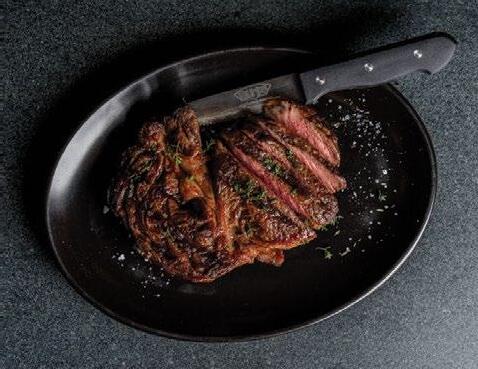
From the legendary tomahawk to the exquisite 10+ marbling rated wagyu ribeye, each cut is a testament to the brothers’ passion. Complement your dining experience with a meticulously curated selection of South Africa’s finest red wines.
Whether you’re a global or local explorer, discerning corporate executive, or celebrating a special moment, Trumps Grillhouse is your ultimate destination.
AT THE SOUTH AFRICAN RESTAURANT AWARDS 2025


Explore: The great Limpopo Skincare
Into Africa: Tanzania & Zanzibar
Into Africa: Botswana
Into Africa: Zambia
Recipes
Photography
Into Africa: Namibia
Cape-Namibia Route
Read: Book club
Soduku

@RoveSouthAfrica
PUBLISHER: Elroy van Heerden-Mays elroy@mediaxpose.co.za
EDITOR: Milou Staub editor@rovesa.co.za
SUB-EDITOR: Samiena Amien sub@mediaxpose.co.za
CONTENT MANAGER: Wadoeda Adams artwork@mediaxpose.co.za
EDITORIAL CONTRIBUTORS



COVER IMAGE Lanzerac
DESIGN & LAYOUT
Shaun van Heerden-Mays Anja Bramley Tia Arendse
PROJECT MANAGER: Hester Kleynhans hester@rovesa.co.za
DIGITAL AND SOCIAL MEDIA Juhi Rampersad / Kyla van Heerden
WEB DEVELOPER Richard Van Staden
SUBSCRIPTIONS: Shihaam Gyer distribution@mediaxpose.co.za
MEDIA PARTERSHIPS: Maurisha Niewenhuys maurisha@mediaxpose.co.za
CHIEF FINANCIAL OFFICER: Shaun van Heerden-Mays
RECEPTIONIST: Jackie Kemp
RETAIL DISTRIBUTION: On The Dot
AIRPORT DISTRIBUTION: Media Support
PICTURE CREDIT: 123rf.com




Disclaimer: The views expressed in this publication are not necessarily those of the publisher or its agents. While every effort has been made to ensure the accuracy of the information published, the publisher does not accept responsibility for any error or omission contained herein. Consequently, no person connected with the publication of this journal will be liable for any loss or damage sustained by any reader as a result of action following statements or opinions expressed herein. The publisher will give consideration to all material submitted, but does not take responsibility for damage or its safe return.

The enigmatic octopus is just one of the animals you’ll meet at the Two Oceans Aquarium. From the magnificent ragged-tooth sharks to the dainty Knysna seahorses, a visit to the Two Oceans Aquarium is your chance to dive into their underwater world! Buy tickets online at: www.aquarium.co.za


THE WORD LUXURY IS DEFINED AS “A CONDITION OF GREAT EASE AND COMFORT”. AMID GREAT BEAUTY, WE MIGHT ADD – ALL OF WHICH THE TEAM AT LANZERAC STRIVES TO CREATE FOR EVERY GUEST SETTING FOOT ON THE GROUNDS OF THE GRACIOUS GRANDE DAME OF THE WINELANDS.
More than 330 years old and just slightly younger than the town of Stellenbosch itself, Lanzerac has guarded the Jonkershoek Valley for centuries.
But old, it is definitely not. It has moved with the times without losing the history, and it still represents and embodies all that is fine in the Cape Winelands.
With 54 en-suite bedrooms and suites, the hotel is nestled amongst old oaks and lush gardens, offering every comfort since David Rawdon transformed the farm buildings into a luxury retreat in 1959. This makes every room different in its size and layout, inspiring a unique design for each of them.

Plush furnishings with awe-inspiring bathrooms set the scene for what will be a true break from reality. One unerringly feels like royalty in a bed bearing the same

... a touch of grandeur guaranteed to make you feel like royalty.”
title, but Lanzerac went a step further, adding extra length for a touch of true grandeur.
With various private spaces in and around Lanzerac, you would be forgiven for getting lost in time and space. But fret not, as a smiling team member is around every corner to guide you to your next adventure on a seemingly simple farm that keeps offering you more and more.
Lanzerac was first known for its wine, before the hotel greeted guests from afar and locals alike. That famous South African varietal, Pinotage, now celebrating 100 years, being bottled under its name, Lanzerac Pinotage 1959, was the first commercially released Pinotage, in 1961. But even prior to that the women who built both the historic cellars on the farm are honoured with our Mrs English Chardonnay. Guests are invited to enjoy the various wines, that are proudly produced by the team, while visiting the estate in one of the multiple eateries or in the privacy of their room.
Space, privacy, and tranquillity are what you can expect from this luxurious getaway, mere minutes from the hustle and bustle of the centre of Stellenbosch.
BY BYRON LUKAS
SPRING IS HERE, BABY! THE AIR’S LIGHTER, THE SKIES ARE SHOWING OFF, AND SOUTH AFRICANS ARE ITCHING TO GET OUT THERE — WHETHER THAT’S CRUISING THE GARDEN ROUTE, CHASING SUNSETS IN THE BUSH, OR MAKING THE MOST OF A STAYCATION IN FLUFFY SOCKS. AND GUESS WHAT? THE RIGHT GADGETS CAN TURN ANY OUTING INTO A MINI MASTERPIECE. HERE ARE FOUR THAT’LL HAVE YOU SAYING, “TAKE MY MONEY!”
Solar-Powered Portable Charger
More sun = more power. Literally. This little lifesaver slurps up sunshine and turns it into juice for your phone, camera, or GPS – no plug point in sight. It’s the hero you want on multiday hikes, sandy beach days, or when Eskom’s feeling moody. Eco-friendly, backpack-friendly, and just plain friendly.
Price: R 2 585 95
Available at www.sustainable.co.za/


K&F Electronics Organizer Pouch
Ever played “Where’s My Charger?” in a bag full of chaos? This pouch is your new bestie. It’s water-resistant, opens like a clamshell for full visibility, and has neat compartments for cables, chargers, earbuds, and memory cards. It even stands upright—perfect for hotel room desks or picnic tables where everything else is rolling away.
Price: R690
Available at www.kfconcept.co.za
Fun fact: These gadgets aren’t just pretty. They’re spring-proof, road trip-proof, and “accidentally spilled my drink”-proof, too.”
Spring is the season to just wing it, but this multitool makes you look prepared, at least. Tighten a wobbly camp chair, snip cord for a gazebo, or pop open a bottle in style. Fourteen tools in one slim design, sturdy enough to handle anything, light enough to make you forget you’re carrying it – until you need it, of course.
Price: R2 070
Available at www.awesometools.co.za


Small speaker, big vibes. This cutie pumps crisp, rich sound for up to 15 hours—whether you’re vibing at sundowners, braaiing with friends, or stuck inside because spring decided to give you a rainstorm. Bonus points for USB-C charging and being waterproof enough to survive that one friend who will knock it into the pool.
Price: R899
Available at www.soundcore.com
BY TEMO MPODI
FROM COBBLESTONE PATHS TO POOLSIDE PERFECTION, THESE FASHION MUST-HAVES WILL KEEP YOU COMFY, STYLISH, AND READY FOR ANYTHING
Comfortable sneakers
1

When Nike said “Just Do It”, they weren’t talking about hobbling through your trip with aching feet. The right travel shoes aren’t just a luxury – they’re a necessity (and worth spending a little extra moola on). Choose comfort-first kicks that let you roam freely without worrying about blisters, corns, or sore soles.
Sneakers? Always a winner. They’re stylish, supportive, and ready for anything – from airport sprints to cobblestone strolls.

2
Sunglasses aren’t just a fashion flex, they’re your first line of defence against harsh UV rays. A good pair protects your eyes while elevating your look. Go classic with sleek black frames that match any outfit, or make a statement with bold colours that
3
Comfortable pants and a t-shirt
The last thing you want are tight kimono pants, or suit pants that take away the joy of feeling free while travelling and enjoying your activities. Leave the office wear for the office and just get comfy!

4
Timepieces today do far more than tick away the hours. Smartwatches are a gamechanger for travellers – monitoring sleep, managing stress, tracking steps, and even handling calls and texts, all from your wrist. Some models come equipped with maps and solar charging, making them the ultimate travel companion.
And let’s not forget the style factor. A sleek, well-designed watch adds a touch of class and elegance to your look, effortlessly blending function with fashion. It’s not just smart – it’s sharp.




























































































WHILE INTERNATIONAL CELEBRITIES FLOCK TO ATHENS FOR HANDMADE SANDALS, SOME OF THE WORLD'S MOST SOUGHT-AFTER ARTISANS ARE WORKING QUIETLY IN OUR OWN BACKYARD, PRODUCING PIECES THAT END UP IN THE MOST EXCLUSIVE COLLECTIONS WORLDWIDE – OFTEN WITHOUT THE FANFARE THEY DESERVE.
In the rolling hills of the KwaZulu-Natal Midlands, Ardmore Design has built something extraordinary: a working studio where over 80 professional artists create pieces that command international attention. Founded by artist Fée Halsted in 1985, what originally started as a skills development initiative has evolved into a serious artistic enterprise.
Christie’s auction house has acknowledged Ardmore artworks as “modern-day collectables.” Their designs appear on Hermès scarves and Cole & Son wallpapers sold in London’s most exclusive design shops. Queen Elizabeth II owned an Ardmore piece, and there is one in the White House collection.
Each artwork involves two or three artists working together – one might create the form, another handles the sculpting, and a third adds the intricate painting. The result is work with a distinctive aesthetic that’s unmistakably South African yet appeals to international luxury markets.

2

At Potterswork, they design and create hand-painted, beautifully crafted tableware combining artistic expression with everyday functionality. A dedicated team of artisans handcraft each piece. What began in a small shop in Kalk Bay in 1986 has grown into a bustling studio in Cape Town filled with colour, creativity and community. Today it is home to 14 talented artists and 20 skilled production staff, many of whom come from nearby disadvantaged communities. Each artist is trained in-house and brings their own story and skills, working together to produce ceramics that are nothing short of world-class. This spirit of passing on knowledge is central to who they are. Over time, each painter develops their own signature style – bold and graphic, soft and organic or rich and with intricate detail – adding to the diverse creative voice that defines Potterswork.co.za.
3
Red Hot Glass in Paarl has been producing gorgeous glasswork for over 25 years and is responsible for some of the biggest glass installations on the African continent. Their pieces furnish many of the world's finest homes, with artists Liz Lacey and David Jackson also creating magnificent glass art currently gracing top hotels and galleries worldwide.
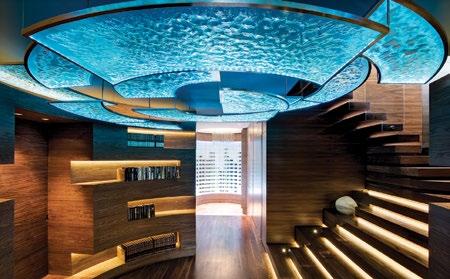
This Venetian-style glass-blowing studio demonstrates a mastery of one of the oldest crafts on earth, creating everything from exquisite hand-blown perfume bottles to elegant vases and imposing architectural pieces.
4
Cape Cobra Leathercraft, established in 1972, is a third-generation family-run handbag and accessories atelier based in Cape Town and using South African raw materials such as ostrich and crocodile leather. Internationally recognised for their timeless and sophisticated designs, they represent the kind of traditional European atelier approach that’s increasingly rare.
South African Leather Academy in the Western Cape offers intensive courses designed to prepare artisans for their own businesses, focusing on traditional handcrafted leather goods. Their mission is to promote the manufacturing of high-quality, genuine leather products using traditional techniques.
What distinguishes these artisans from typical craft producers is their engagement with serious art markets and luxury industries. They’re not creating for the curio trade – they’re supplying galleries, designers, and collectors who understand quality and are willing to pay for it.
For South Africans interested in supporting exceptional local talent, these workshops offer opportunities to commission original pieces or purchase work that will appreciate in value. Many of these artists have waiting

lists for custom commissions, particularly for interior design projects or private collections.
The remarkable thing about South African artisans is how they’ve achieved international recognition while remaining relatively unknown domestically. Ardmore Ceramics sell in upmarket galleries from New York to Tokyo. Ndebele-inspired designs influence luxury fashion collections. Red Hot Glass creates installations for world-class venues.
The best South African artisans have achieved something remarkable: they’ve maintained cultural authenticity while creating works that compete in global luxury markets. Their success demonstrates that traditional techniques, when executed with mastery and vision, can produce contemporary art of exceptional quality.






THE DAYS OF LYING POOLSIDE WITH A COCKTAIL FOR AN ENTIRE HOLIDAY ARE WANING. TODAY’S TRAVELLERS ARE INCREASINGLY SEEKING DESTINATIONS THAT CHALLENGE THEIR BODIES, EXPAND THEIR FITNESS HORIZONS, AND LEAVE THEM FEELING STRONGER THAN WHEN THEY ARRIVED.
Welcome to the world of “fitcations” –where your holiday becomes your gym, your adventure playground, and your wellness retreat all rolled into one. South Africa has emerged as a global leader in this sport-based travel revolution, offering everything from championship mountain biking trails to surfing lessons in Jeffreys Bay, trail running through the Drakensberg, and yoga retreats overlooking pristine coastlines.
The statistics speak volumes about this growing trend. According to recent tourism research, over 76% of travellers now consider physical activities an essential part of their holiday experience, while wellness tourism has grown by 7.5% annually, significantly outpacing general tourism growth. People are no longer content to return from holiday feeling sluggish – they want to

come back energised, having learnt new skills, and in better shape than when they left.
Few countries can match South Africa’s natural diversity when it comes to sport-based adventures. The Western Cape’s Table Mountain offers some of the planet’s most spectacular trail running, with routes ranging from gentle coastal paths to challenging mountain ascents. The annual Two Oceans Marathon draws thousands of international runners who combine race participation with extended South African holidays.
“I came for the marathon but stayed for the trails,” says Emma Rodriguez, a Spanish runner who has returned to Cape Town four times. “There’s something magical about running through vineyards at sunrise, or along clifftops, with whales breaching below.”

The mountain biking scene has exploded across all nine provinces, with dedicated adventure packages from the Garden Route’s forest singletracks to the Drakensberg’s mountain trails. Stellenbosch has become a particular favourite, where visitors combine premier mountain biking with wine tasting – it’s the perfect balance of exertion and indulgence.
Jeffreys Bay has evolved far beyond its reputation as a surfer’s paradise, now hosting surf schools offering week-long programmes that combine technique improvement with cultural immersion. The emergence of “surf therapy” programmes adds another dimension, combining the physical challenge of surfing with mindfulness practices for holistic wellness.
This boom in sport-based travel is generating significant economic benefits for local communities. Adventure tourism operators report that fitcation travellers typically stay longer and spend more than traditional tourists, often booking multiple activities and seeking authentic local experiences.
Small towns are capitalising on this trend. Places like Clarens in the Free State have transformed themselves into adventure hubs, offering everything from whitewater rafting to rock climbing, while maintaining their authentic charm.
The rise of fitness technology has enhanced the active travel experience significantly. Local operators now offer GPS-guided cycling routes, downloadable running trails with historical commentary, and virtual coaching sessions accessible anywhere in the country.
Perhaps most importantly, the fitcation movement aligns perfectly with sustainable tourism principles. These activities typically have minimal environmental
Events to Build Your Adventure Around:
• The Absa Cape Epic – 15 March: One of the world’s world’s most televised mountain bike races returns for its 23rd edition. This eight-day stage race covers over 616km across stunning SA terrain.
• Two Oceans Marathon – 5 April: The world’s most beautiful marathon continues its tradition, taking runners around the spectacular Cape Peninsula.
• Sanlam Cape Town Marathon – 24 May: Moving from October to late May, this race pursues recognition as Africa’s first Abbott World Marathon Major event, offering perfect autumn weather for marathon running.
• Ballito Pro – June/July: South Africa’s premier surfing competition returns to the KwaZulu-Natal coast, attracting elite surfers and thousands of spectators.
• Knysna Forest Marathon – July: This exclusive 42km race through the famous Southern Cape Forests is limited to around 800 runners.
impact while maximising economic benefit to local communities. Many operators actively participate in conservation efforts, with guests contributing to trail maintenance and wildlife monitoring programmes.
Spring and autumn offer ideal weather conditions for most activities, while summer months are perfect for water-based adventures and winter provides excellent hiking conditions.
Key considerations include matching activities to your current fitness level while allowing room for progression, choosing operators with strong safety records and local knowledge, and building in rest days to explore cultural attractions and local cuisine.
The fitcation revolution isn’t just changing how we travel – it’s redefining what a perfect holiday looks like. In South Africa, that perfect holiday might involve climbing a mountain at sunrise, surfing championship waves at midday, and falling asleep under the stars after a day of adventure.
For today’s travellers, who believe the best souvenirs are stronger muscles, new skills, and unforgettable experiences, South Africa offers active holidays that deliver on every level. The only question left is this: which adventure will you choose first?
SECLUDED DEEP IN THE MPUMALANGA HIGHVELD LIES THE HAMLET OF CHRISSIESMEER
– A QUIET ESCAPE WHERE OVER 270 SHIMMERING LAKES AND PANS CREATE SA’S OWN “LAKE DISTRICT”. FAR FROM THE TOURIST BUZZ OF SABIE OR GRASKOP, THIS REMOTE GEM, 1 500 METERS ABOVE SEA LEVEL, OFFERS RAW BEAUTY, RARE WILDLIFE, AND A CHANCE TO UNPLUG
Why visit Chrissiesmeer?
Known as Matotoland (“frog land”) in Siswati, Chrissiesmeer is a haven of wetlands formed by ancient subsidence and peat bogs, hosting cranes, flamingos and intensely starry skies. At 300km from Johannesburg, the hamlet’s isolation, gravel roads and minimal infrastructure keep it off the radar, making it ideal for twitchers, anglers, and explorers seeking Mpumalanga’s quieter side.
What to do
Chrissiesmeer’s magic lies in its outdoor adventures

and cultural quirks. Pack your gear and dive in...
Angle in glassy lakes
Lake Chrissie, South Africa’s largest natural freshwater lake (9x3km), teems with carp, bass, and trout. Local guides at Teen Die Muur Resort can point you to prime spots for fishing.
Tech Tip: A portable fish finder like the Deeper Smart Sonar works wonders in murky pans. You’ll need to book a permit for these.
With 287 bird species calling the area home, Chrissiesmeer is a birder’s paradise. You’ll spot flocks of flamingos (up to 20 000 in summer), grey crowned cranes, or, if you’re lucky, the elusive wattled crane along a 60km self-drive route through the wetlands. September to March is prime time –this is when migratory waders arrive. After a guided tour? Contact local bird expert Peter Borradaile on 072 076 9995.
Tech Tip: Download the eBird app to log sightings and track rare species like the Southern bald ibis. A Nikon Prostaff binoculars will bring distant cranes into focus.

Join the December Frog Festival, where locals and visitors don wellies to hunt for 13 frog species, from tiny Boettger’s dainty ones to rattling tree frogs. It’s muddy, chaotic fun.
Tech Tip: Use a waterproof Insta360 GO 3 camera to capture the action without ruining your phone.
Wander the Welgelegen farm to find ancient San rock paintings engraved and painted on rocky shelters, whispering of a millennia-old past. These delicate artworks are a fascinating glimpse into Mpumalanga’s Later Stone Age history.
Tech Tip: The PlantNet app doubles as a guide to spot rare fynbos while you search for art sites.
Chrissiesmeer’s remoteness means pitch-black nights perfect for stargazing. Set up camp at Teen Die Meer chalets for unobstructed views of the Milky Way.
Tech Tip: A Celestron Skymaster 15x70 binoculars is great for spotting constellations – and budget-friendly, too. Pair with the SkySafari app for real-time star maps.

Hike and cycle the Highlands Pedal or trek the Mpumalanga Highlands Route, weaving through rolling hills and lake-dotted vistas. It’s scenic, and ideal for mountain biking or horseback riding.
Tech Tip: A GPS wristwatch like the Garmin Instinct 3 tracks routes and elevation, essential for unmarked paths.
From Johannesburg’s OR Tambo Airport, drive 250km (2h40m) via the N17 or 265km (2h45m) via the N12. Chrissiesmeer is approximately 50km from Ermelo. Gravel roads demand a sturdy vehicle; 4x4s are ideal in the wet season.
Visit September to March for peak birding, with flamingos and cranes everywhere you go. Wildflowers bloom from August to February, with the festival happening in late January. The Frog Festival (in December) is a muddy blast, while October/ November’s Craft Liquor Festival (date not confirmed at the time of going to print) adds boozy fun.
Local Tip: Pack a lightweight rain jacket for summer showers and a warm layer for chilly Highveld nights.
For more on Chrissiesmeer, email chrissiesmeer5@gmail.com or call 068 054 1763. To keep in touch or up to date, visit @chrissiesmeer_ eco_tourism on Instagram, or visit our official website.
WE CHAT TO PROFESSOR THOKO MAYEKISO, THE OUTGOING VC OF THE UNIVERSITY OF MPUMALANGA, ABOUT THE PLACES SHE’S BEEN, AND THE PLACES STILL ON HER BUCKET LIST
Professor Thoko, tell us a bit about your hometown, Mcobothini. and your family homestead, Caledonia.
Mcobothini Location is just outside the town of Lusikisiki, which is en route to Port St Johns. Lusikisiki has lush vegetation and densely populated forests with undulating hills. It’s so pleasing to the eye – a veritable natural garden. The torrential rainfall, constant and copious, means the trees are a vivid green and the fields yield abundant crops. Fruit orchards and vineyards abound: avocado, guava, banana, granadilla, grape…. And sheep and cattle have plenty to graze on. The richness of the soil attracted my grandfather, who came from Middledrift (iXesi) to settle in Lusikisiki.
Caledonia, our homestead, has a certain grandeur, and a kaleidoscope of colour emanates from the various ways in which house walls are usually painted. The house stands at an elevated level and is visible from a distance. It has a huge verandah with stairs leading up to it. My father, a history teacher, used to tell us stories there, mostly about the history of South Africa and that of countries such as France, Germany and Russia.
Would you describe yourself as a city traveller or nature lover?
I’m more of a city traveller, although I love exploring nature. I can definitely say I’m not into caravans and camping, though. I prefer a combination of comfort
and nature. Even on holiday, I’d still want to have access to my cellphone, wi-fi and TV. Nature has its place, but my inclination is towards a mix of nature and my creature comforts.
Most of them are business trip, so I plan my travel around the business to be conducted. I allow time before the commencement of the official programme, especially if the travelling involved more than 12 hours. I find it important to build in time for unexpected contingencies, as travel can be unpredictable at times. Airline schedules are usually good, but there’s no accounting for bad weather and other delays. So it’s important to have an itinerary that has elements of flexibility. This ensures that I am alert and fully prepared for the meetings, but that I’m also not thrown when the unexpected happens. And importantly, that I have time to make other arrangements. Whenever possible, I make sure that I factor in time to go to the spa for a massage, jacuzzi and sauna.
The plane ride itself. It allows me time to sit and collect my thoughts. The pressures of the ViceChancellor’s office often make it difficult to carve out time for reflection, so just sitting and reading a novel or magazine helps me relax. The concept of “sharpening the saw” – relaxing the mind and

unplugging – helps me recharge. Travelling to new places, seeing new faces and the unique features of each country is in itself fascinating.
Are there any other places in South Africa that are still on your bucket list? Why?
The Northern Cape. I’ve never been, and I’d like to visit the Sol Plaatje University in Kimberley, which was established at the same time as the University of Mpumalanga. The Big Hole in Kimberley is something I’ve yet to see. From what I’ve seen from photographs and heard from friends who’d visited the region, the arid landscape and vast expanses give the Northern Cape a certain uniqueness.
Can you tell us a bit about your first international trip?
The first place I travelled to internationally, was Germany. This was in the early Eighties, when I was awarded a German Academic Exchange (DAAD) scholarship to pursue postgraduate studies in Psychology at the Free University Berlin. I completed my doctorate in Psychology there.
My international travel spans a period of 45 years. I have been to all continents of the world, and visited countless countries – 23 in Europe; 13 in Africa; 12 in Asia; 4 in Latin America; 2 in North America and I visited Australia. I’ve been to most of those several times in the course of my work. I visited Jamaica, Mexico and Brazil once only, though. Sometimes, while watching the weather report and seeing the various cities on the map, I’m quite struck by the number of cities I've visited. I’ve been toId to always buy a fridge magnet and a coffee mug whenever I visit a country.

What is the last place you’ve travelled to?
Kaohsiung City, Taiwan – in July. The purpose of the trip was to visit the National University of Kaohsiung, with which we have a Memorandum of Agreement. The visit included the signing of the Memorandum of Agreement focusing on Student Exchanges, which will pave the way for our students to study in Taiwan.
If you could travel to any time in the past, where would you go?
The East has its attraction – unique places like . Malaysia, Australia, Ghana, Germany and Canada... The UK and Kenya, too.
About the Tfokomala Hotel: Why did the University of Mpumalanga decide to acquire a 4-star Hotel?
The University offers Hospitality Management and Culinary Arts as flagship programmes. The Tfokomala Hotel provides the students with excellent opportunities for experiential learning from the outset of their education and training. It provides for the integration of theory and practice, which is something UMP is adamant about. The Hotel also offers Work Integrated Learning opportunities for some of the students during their second and third years of study.
We believe that this provides UMP with great value proposition. The University decided to aim for a 4-star grading in order to promote the value of excellence in operations. As it's a 4-star hotel, the furnishings have been carefully selected. The amenities, ambience and overall service are outstanding. And the staff exude excellence and warmth. This is why the Tfokomala Hotel has retained its 4-star grading since its inception. Incidentally, Tfokomala is a Siswati term meaning “relaxation”. We really are providing our guests with a place to relax in grand style.
The concept of “sharpening the saw” – relaxing the mind and unplugging– helps me recharge.”

DISCOVER 4-STAR LUXURY AT TFOKOMALA HOTEL & CONFERENCE CENTRE, UNIQUELY SITUATED WITHIN THE UNIVERSITY OF MPUMALANGA. ENJOY EXCEPTIONAL COMFORT, INSPIRING SURROUNDINGS, AND GENUINE HOSPITALITY RIGHT AT THE DOORSTEP OF THE KRUGER NATIONAL PARK.
Welcome to the Tfokomala Hotel & Conference Centre, proudly located inside the University of Mpumalanga, one of the first hotels of its kind in South Africa.
As a distinguished 4-star hotel, we combine academic excellence with world-class hospitality, offering an inspiring environment for both business and leisure. The hotel offers the perfect blend of luxury accommodation, exceptional hospitality, and world-class facilities.
Whether you’re visiting the province for business or leisure, our modern conference venues, stylish rooms, and exquisite dining experiences guarantee unforgettable moments.
Wholly owned by the University of Mpumalanga, Tfokomala Hotel offers the following:
• 4-star luxury accommodation & service
• State-of-the-art conference facilities
• Exquisite dining inspired by local flavours
• Elegant rooms & suites for comfort and style
• Serene gardens & relaxed surroundings in the heart of Mpumalanga
BOOK NOW for an unforgettable stay! 013 002 0400 063 795 8833 reservations@tfokomala.co.za https://tfokomala.co.za

Follow on
Tfokomala Hotel & Conference Centre @Tfokomala @tfokomalahotelconference

What is the weirdest food you’ve ever tried while travelling?
Snails, in France. Taking strong black coffee without milk, too. But those are the experiences that come with travel and meeting different cultures, isn’t it.
Most of your travel has been for work. What is your favourite holiday destination?
My favourite local destination is Mpumalanga, which is exquisitely beautiful generally. But, to be precise – the Sanbonani Resort in Hazyview, Mpumalanga. I find the setting very relaxing, with spacious chalets and a river running behind. The sound of rippling waters always soothes, right? This resort has all the amenities that make a holiday relaxing and memorable – a pool, spa, restaurant and lovely walking trails. We usually go there in a group of about 10 friends. The great company and beautiful surrounds make it a favourite destination for me. It’s about an hour’s drive
a colleague, via Frankfurt. We were informed that we didn’t need visas for Portugal as we had official passports. We travelled from Nelspruit to OR Tambo International and checked in comfortably. As we we were boarding, we were told that we needed a Schengen visa for the transit in Frankfurt and were summarily put off the plane. We were very anxious not to miss the first day of the meetings as we were part of a Province of Mpumalanga delegation. Fortunately we managed to get seats on Air France and travelled via Paris on the same night. This is what I mean by the unpredictability of travel. That experience taught me the value of handling similar situations with quick thinking and a solutions-driven mindset.
You win the lottery tomorrow – where are you headed first?
[Laughs] I’d travel to the US to visit family. There are also philanthropy projects I would consider:

from where I’m based, so it’s also great for a quick breakaway in the middle of a hectic schedule.
Do you have a funny or strange travel story you’d like to share?
Erm, let me see… I was travelling to Portugal with
empowerment initiatives for girl-children and young women remain close to my heart, so I would travel to places with successful programmes in that field and learn how to implement them here. I’d also want to travel to as many African countries as possible, to learn more about our vast, diverse continent.



WILDLIFE PHOTOGRAPHERS OFTEN SPEND HOURS WAITING FOR THAT ONE SHOT THAT ENCAPSULATES THE LIFE, BEAUTY AND MAJESTY OF THE WILD. HERE ARE JUST SOME OF WILDLIFE SHUTTERBUG WOLFGANG HASSELMANN'S FABULOUS CLICKS.
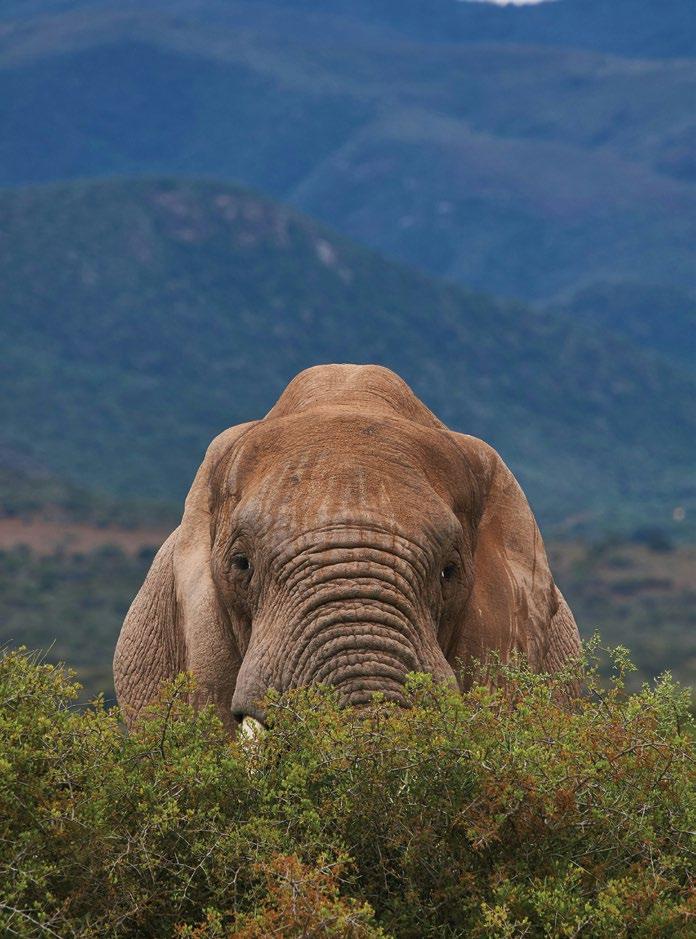
AN ELEPHANT IN A BUSH.
THIS BEAUTIFUL BIRD IS A CAPE STARLING.

GI G – A GRASSHOPPER (IN FULL ARMOUR) PERCHED ON A GREEN LEAF
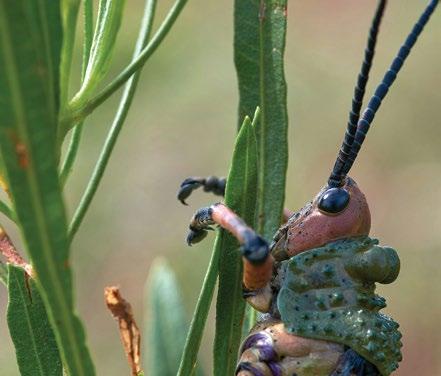
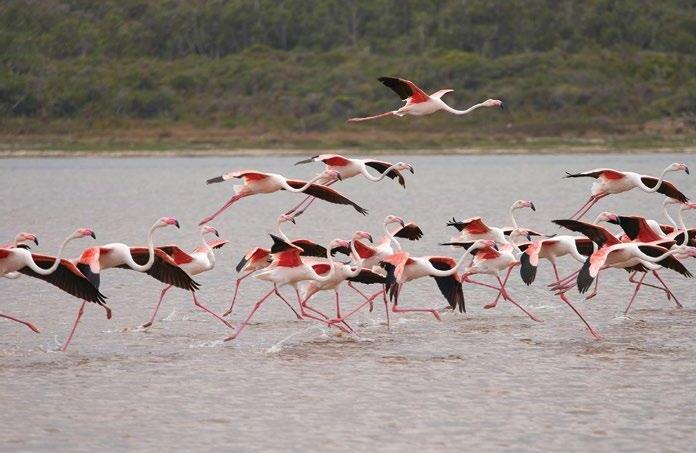
A FLOCK OF PINK FLAMINGOS GEARING UP FOR THE FLIGHT.
BY ANDRE STEYN
THOUGHT
Ijust completed a spectacular road trip; and here’s why you need to plan this for next year.
Three weeks ago, I believed I knew South Africa. Then I spent 14 days driving through the Northern Cape during peak flower season, and everything changed. This wasn’t just a road trip – it was a complete reframing of what our country offers beyond the obvious tourist routes.
I’m writing this sitting at my desk in Cape Town, still processing what I experienced in August. The wildflower displays were beyond anything I’d imagined, but the real revelation was everything else: world-class astronomy facilities, desert wine estates that rival Stellenbosch’s, salt pans so vast they redefine your sense of scale, and predator sightings to match the Kruger National Park.
If you’re planning your 2026 travel calendar, block out mid-August immediately. This is the road trip that separates casual South African travellers from those who truly understand what this country offers.
The cosmic detour distance: 345km (4 hours)
We started with a brilliant detour that most people miss entirely. Sutherland hosts the Southern African Large Telescope (SALT) and is the gateway to the MeerKAT Observatory; the world’s most powerful radio telescope array. Standing among those 64 massive dishes near Carnarvon felt like stepping onto another planet.
The SALT day tour was incredible; seeing cuttingedge astronomy facilities that put South Africa at the

forefront of space science was an eye-opener and a proud moment. Our guide, a working astronomer, explained how they’re discovering new planets and black holes from this remote Karoo town. That night, viewing Saturn through their 14-inch telescope, I felt genuinely emotional. You realise how you are both small in the vast universe, and transcendant.
Where we stayed: Primrose Cottage B&B in Sutherland. The owners are Observatory veterans with their own telescopes for after-dinner stargazing and interesting conversation.
Pro tip: Book SALT tours well ahead (+27 23 571 2436). MeerKAT Open Days happen annually but fill up fast.
annually but fill up fast.
The alien landscape distance: 285km (3.45 hours) Nothing – and I mean nothing – prepared me for Verneukpan. This 57km x 11km perfectly flat salt pan exists in a category of its own. The silence was so complete it became a physical presence. My ears literally hummed to compensate for the absence of noise.
We wild-camped directly on the pan itself, following the track of Sir Malcolm Campbell’s still-visible 1929 failed speed record attempt. At sunset, the entire pan turned a molten gold. The night sky here redefined what I thought was possible: zero light pollution revealing star fields so dense they looked artificial. At sunrise, it was like watching the world being painted in real-time.
Reality check: This isn’t for everyone. No facilities, extreme temperatures, and genuinely isolated. But if you want to experience true wilderness and understand why early explorers called this place “verneuk” (cheat), nothing compares.
Where we stayed: We wild camped (with permission) on Kareeboomdam Farm. The owner showed us “Campbell’s Koppie”, a viewpoint overlooking the entire pan.
Desert viticulture discovery distance: 255km (3 hours) Here’s where this trip delivered its biggest surprise: the Northern Cape produces serious wine. I had no idea! Oranje Rivier Wine Cellars is the largest co-operative winery in the southern hemisphere, sourcing from 750+ farmers across 300km of desert vineyards.
The tasting at their Upington headquarters was revelatory: desert-grown Chenin Blanc and red blends that hold their own against Western Cape wines. At Bezalel Estate in Keimoes, we did wine tasting on an actual river boat while watching the historic paddle waterwheel that once irrigated these vineyards. The “Green Kalahari” viticulture feels impossible; lush vineyards thriving in harsh desert conditions, creating a microclimate that shouldn’t exist. This was easily our trip’s most unexpected highlight.
Where we stayed: African Vineyard Boutique Hotel & Spa at Kanoneiland: luxury accommodation literally among the vines, with spa treatments using grapeseed extracts.
Wine discovery: Die Mas brandy and gin made from local grapes, plus Kalahari Craft Beer brewed on-site.
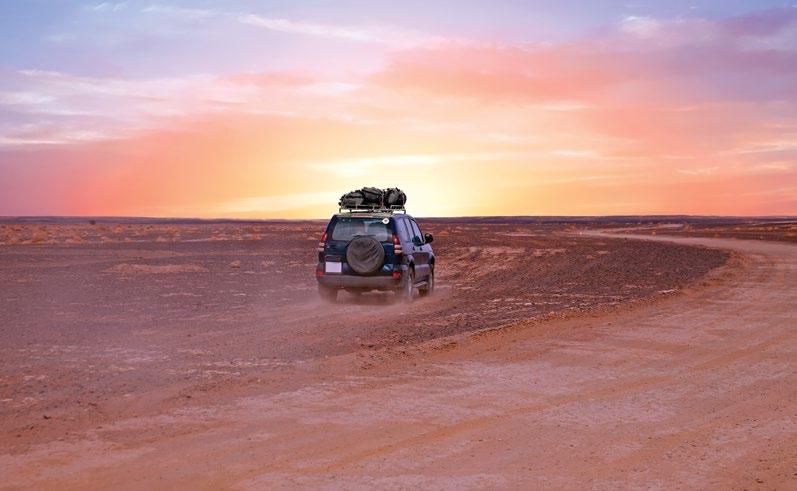
Into the real wild distance: 250km (2.25 hours)
Kgalagadi delivered everything I’d hoped for, and more. We saw lions daily; massive black-maned males using camel thorn trees as lookout posts. Our best sighting was a coalition of three adult males resting barely 10 metres from our vehicle, completely relaxed in the afternoon heat.
The park’s remote location means you’re often the only vehicle at sightings. We spent an entire morning watching a cheetah hunt springbok – with no other humans in sight. The night drive with rangers revealed brown hyenas, bat-eared foxes, and the resonant rumble of lions roaring across the Kalahari darkness.
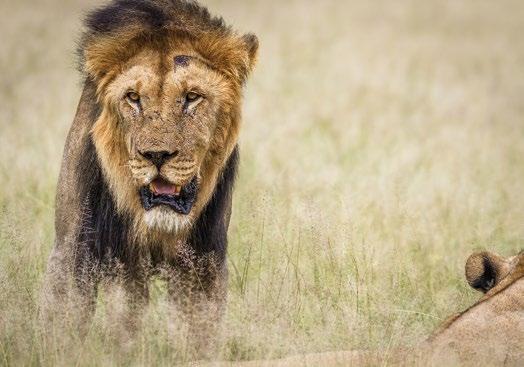
Where we stayed: Two nights at SANParks Twee Rivieren (The Park headquarters), then two nights at Nossob, deeper in the park. The latter has no cellphone reception, adding to the wilderness experience. It’s game-drive gold! Early morning drives along the Auob riverbed produced our best predator sightings. The Park’s 264 bird species included massive kori bustards and striking secretary birds.
The thundering finale distance: 370km (4 hours) Augrabies was the perfect finale to an incredible journey. Recent good rains had the Falls thundering at full power; the sound was audible from our accommodation a kilometre away. The multiple viewing platforms each offer different experiences: panoramic views from afar, then progressively closer until you’re standing where the spray soaks you completely.

The granite gorge setting, with quiver trees dotting the landscape, felt like something from another planet. We did the 5km hiking trail to various viewpoints, then cooled off in the Park’s swimming pool, a luxurious soak after days in the Kalahari heat.
Where we stayed: SANParks cottages within the Park. The accommodation here is some of their best anywhere.
Photo opportunity: The quiver tree forest under the moonlight, with the Falls thundering in the background is just pure South African magic.

For professional car servicing, mechanical repairs, and expert advice, you can count on us to meet all your car needs. No matter the make or model, your car is always in excellent hands at Bosch Car Service.
We offer a wide range of mechanical repairs, including braking, diagnostics, auto-electrical systems, clutch repairs, engine and gearbox repairs, and much more. We take our service excellence seriously, guaranteeing both our parts and labour.
Book your next service or repair today! www.boschcarsa.co.za



Cape Town return distance, via the “Bulb Capital”: 380km from Augrabies (4.5 hours)
Instead of taking the direct N7 route back to Cape Town, we made a crucial detour through Nieuwoudtville – I’m so glad we did. Even in mid-August, the Hantam National Botanical Garden was still boasting incredible displays. This is where you truly understand why it’s the “bulb capital of the world.”
Walking through the 6 200-hectare garden, our guide showed us patches where a single spadeful of earth contains nearly 100 bulbs. The 1 350 plant species include varieties found nowhere else on earth, some so rare they bloom only after specific rainfall patterns.
The late-season flowers here were different from the mass displays we’d missed earlier in the season, but in many ways were more special. Delicate lachenalias, hardy vygies, and the last of the Namaqualand daisies created displays perfect for intimate photography.
Essential stop: Nieuwoudtville Flower Reserve Visitors Centre for maps of current blooms and botanical insights that transformed how we understood the entire region.
Bonus discovery: Local farm stalls selling bulbs and seeds; we brought home authentic Namaqualand plants for our Cape Town garden.
• Start booking now for August 2026. Flower season peaks mid-August, and the available accommodations fill up months ahead; especially the Kgalagadi’s wilderness camps. The investment is significant (our trip cost R42 000 for two), but this ranks among the most transformative travel experiences South Africa offers.
• Critical timing: Plan for mid-August 2026. Earlier is better for northern flowers; later works for southern displays. The weather is perfect – crisp mornings, warm days, clear skies.
• This isn’t just about ticking boxes or collecting Instagram shots. The Northern Cape reveals South Africa at its most elemental – vast, wild, and utterly transformative. It doesn’t just show you incredible sights; it changes how you see our entire country.
• To reiterate: Book accommodation now for August 2026. Miss this timing, and you’ll wait another year to understand what all the fuss was about.
this trip changed everything
After 14 days in the Northern Cape, I realised I’d been missing an entire dimension of South Africa. While everyone fights the Garden Route traffic or the queues for Table Mountain’s cable cars, this region offers experiences that simply don’t exist anywhere else.
The scale redefines your sense of space. The silence at Verneukpan was more profound than any meditation retreat. The astronomy facilities put South Africa at the cutting edge of space science. The desert wine estates challenged everything I thought I knew about South African viticulture.
Most importantly, this felt authentically South African in a way that many tourist destinations no longer do. Real people doing extraordinary things in impossible landscapes, creating experiences that exist nowhere else on earth.

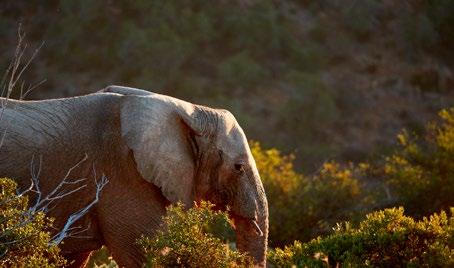



BY DR MARTIN BRIGGS
WHY THE JOURNEY THROUGH SOUTH AFRICA’S GREAT KAROO DESERVES MORE THAN A FLEETING GLANCE.
Most travellers thunder along the N1 highway between Cape Town and the northern provinces, treating the vast expanse of the Great Karoo as something to endure, rather than explore. Yet those who dare to venture off the beaten track discover one of South Africa’s most captivating regions, the Camdeboo, where dramatic landscapes and rich literary heritage converge in spectacular fashion.
The Camdeboo region unfolds like a masterpiece painted on an enormous canvas. Here, the towering dolerite columns of Desolation Valley rise majestically just outside Graaff-Reinet, their ancient geological formations standing sentinel against the backdrop of endless plains. These vast stretches extend from the foothills of the aptly named Sneeuberg Mountain

(Snow Mountain) Range in the north to the rugged wilderness of the Baviaans Mountains in the east.
This is where the tinder-dry Koup Karoo begins its transition into something altogether more varied and compelling. The Koup, often dismissed by hurried travellers as a barren wasteland, reveals its secrets only to those patient enough to look beyond first impressions.
Step away from the main arterial route and the Camdeboo region transforms before your eyes. What initially appears as monotonous scrubland gives way to a dramatic tapestry of towering mountains, hidden valleys, and sweeping vistas that stretch to distant horizons. Here lie some of the Karoo’s most beautiful and intriguing towns and villages, each with
stories etched into their dusty streets and weathered buildings.
The landscape continues its metamorphosis as you travel westward through the gentler terrain of the Eastern Karoo, eventually reaching the lush rolling hills of Settler Country and the former Transkei in the east. It’s a journey through multiple worlds, each with a distinct character and charm.
Against this backdrop of vast plains that dwarf tiny Karoo towns like Aberdeen and Pearston, one farm stands out as both a working concern and a literary landmark. Cranemere Farm, home to the Palmer family for generations, provided the inspiration for Eve Palmer’s acclaimed novel The Plains of Camdeboo, considered one of South Africa’s great literary works.
Palmer’s beautifully crafted prose captures life across several generations on these Great Karoo plains. Her pilgrimage to Cranemere Farm became the foundation for a quintessentially South African novel that chronicles the rhythms of rural life, the challenges of farming in this harsh yet beautiful landscape, and the enduring connection between people and place.
Today, the descendants of Eve Palmer, including Alex Palmer, continue to call this Karoo oasis home. The farm remains a working concern, testament to the resilience and adaptability that Karoo life demands. It’s a place where the past and present coexist, where literature comes alive in the daily rhythms of farm life, and where the vast landscape continues to shape those who dare to call it home.
Getting there: The region is easily accessible via the N1 highway, with Graaff-Reinet serving as an excellent base for exploration.
Best time to visit: Autumn (March-May) and spring (September-November) offer the most comfortable temperatures for outdoor activities.
Must-sees & experiences:
• Explore the geological wonders of Desolation Valley.
• Visit the historic town of Graaff-Reinet with its beautiful Cape Dutch architecture.
• Experience the pristine wilderness of the Baviaanskloof Mountains.
• Enjoy Karoo-inspired cuisine at De Camdeboo Restaurant at The Drostdy Hotel.

The Great Karoo reveals itself slowly, rewarding those who look deeper. Here, the revelation is especially profound.”
Accommodation: From charming guesthouses in Graaff-Reinet to wilderness camps in the Baviaanskloof Mountains, the region offers accommodation to suit every taste and budget.
The Great Karoo has always been a place that reveals itself slowly, rewarding those who take time to look beyond the surface. Here, the revelation is particularly profound. Dramatic landscapes, rich history, and living literary heritage combine to create an experience that lingers long after you’ve returned to the main highway.
So, next time you’re travelling the N1, consider taking a detour into the Camdeboo. Allow yourself to be dwarfed by the vastness and inspired by the resilience of those who call this place home. Perhaps you’ll even discover why this harsh yet beautiful landscape has captured the imagination of writers and travellers for generations. The plains of Camdeboo are waiting – not just to be crossed, but to be truly discovered.
LET’S BE BRUTALLY HONEST: WHEN MOST SOUTH AFRICANS THINK “KAROO,” THEY PICTURE ENDLESS STRETCHES OF N1 TEDIUM PUNCTUATED BY ROADKILL AND PETROL STATION PIES. BUT HERE’S THE THING ABOUT ASSUMPTIONS; THEY’RE USUALLY WRONG, AND SPECTACULARLY SO WHEN IT COMES TO OUR VAST SEMI-DESERT HEARTLAND.
The Karoo renaissance is real, and it’s happening right now. While Cape Town battles traffic and Joburg suffocates in smog, a quiet revolution is unfolding in these seemingly forgotten towns. Artists are relocating, foodies are pilgrim-ing, and stressed urbanites are discovering what locals have always known: the Karoo doesn’t just restore your soul; it rewrites your definition of the good life.
Pack your preconceptions away with your city stress; you won’t be needing either. These five towns will shatter every preconception you have about desert living.

Prince Albert: An unexpected foodie capital
The surprise: This isn’t some dusty pit stop. Prince Albert has quietly become the Stellenbosch of the desert, complete with olive farms, award-winning restaurants, and artisanal everything.
Situated at the foot of the dramatic Swartberg Pass, Prince Albert looks like it was designed by someone who read too many European travel magazines and decided to build the perfect village in the middle of nowhere. The result? A town so charming it almost feels fictional.

The town’s foodie credentials are staggering. Gay’s Guernsey Dairy produces mozzarella that would make Italian nonnas weep. O for Olive serves farm-to-table cuisine that puts most Cape Town restaurants to shame. At Jeremy’s Restaurant and Wine Bar, chef Jeremy pairs local Karoo lamb with wines that have never seen a supermarket shelf.
But here’s the real magic: Prince Albert Café operates in an 18th Century building where the owner, Marion, serves dinner by candlelight six nights a week. “The town is surrounded by farms and famous veggie patches,” Marion explains, “making it ideal for fresh, quality farm-to-table cuisine.” Book ahead though – the intimate Café has only eight tables.
The reality check: Accommodation ranges from R900 for guesthouse rooms to R3 500 for luxury self-catering cottages with mountain views. Karoo View Cottages offers 5-star luxury with solar power (yes, load shedding backup), while The Swartberg Hotel provides Victorian elegance in the heart of town.
What Joburg doesn't have: Saturday morning markets where you buy citrus fruits directly from the farmer who grew them; olive oil tastings in centuries-old homesteads, and gin tastings at the Green Prince Gin Bar, where the botanicals are foraged locally.
Practical magic: It’s 4.5 hours from Cape Town, 6 from Joburg. The Swartberg Pass is a national monument; drive it at sunset and understand why people relocate here immediately after their first visit.
A weekend in any of these towns costs less than dinner and drinks in Sandton. A weeklong escape costs less than most people spend on petrol in a month. But the perspective shift? That’s priceless.”



Nieu-Bethesda: art meets astronomy
The surprise: This village of 1 200 people has produced more internationally recognised art per capita than most major cities. It’s also one of the darkest places on earth; perfect for stargazing.
Helen Martins put Nieu-Bethesda on the map when she transformed her home into The Owl House; a psychedelic wonderland of concrete sculptures and mirror mosaics that attracts visitors from around the globe. But that was just the beginning...
Today, the village is home to Mukti, described as “the most stylish retreat in the Great Karoo,” and Dustcovers, a bookshop that’s become a pilgrimage site for literary types. The annual Schreiner Karoo Writers’ Festival honours Olive Schreiner, author of The Story of an African Farm, and transforms this tiny village into South Africa's literary capital for an entire weekend.
The astronomy angle: With virtually no light pollution, Nieu-Bethesda offers some of the clearest night skies in the southern hemisphere. Local guides run star tours that make you realise just how much the city has stolen from you.
The creative scene: Ganora Farm houses an artefact and fossil museum where you can see coelacanth fossils and learn about the area’s 250-million-year geological history. Local artists’ studios dot the streets, selling everything from handwoven textiles

to sculptures that capture the Karoo’s otherworldly beauty.
Reality check: Basic B&B accommodation from R1 200, luxury farm stays from R2 800. The village has one restaurant, but it sources everything locally and the quality is exceptional.
What cities can’t offer: Silence so profound you can hear your own heartbeat. Art created by people who choose isolation over recognition. Night skies where the Milky Way looks like a celestial highway.
Cradock: Victorian grandeur meets adventure sports
The surprise: This town hosts one of SA’s most gruelling sporting events and boasts some of the country’s finest Victorian architecture outside of Cape Town.
Cradock sits in the lap of the Kaga Mountains, surrounded by the kind of scenery that makes you understand why early settlers thought they’d found paradise. The town centre is a Victorian time capsule, with Church Street alone housing enough architectural gems to keep heritage enthusiasts busy for days.
But Cradock’s secret weapon is the Fish River Canoe Marathon; “the toughest single-stage MTB event in the world” that starts here and ends at Jeffreys Bay. When thousands of athletes and supporters descend on this town of 30 000 people, the energy is electric.

The adventure factor: The Cradock Agricultural Show, over 150 years old, attracts farming royalty from across the Karoo. But it’s the mountain biking and river activities that are putting Cradock on adventure tourism maps. The surrounding mountains offer trails ranging from gentle farm roads to serious single-tracks.
The history hit: This is where you’ll find the kind of history that doesn’t make it into school textbooks. Ghost tours reveal stories of frontier life, while heritage walks showcase buildings that have survived everything from wars to economic downturns.
Reality check: Guesthouse accommodation from R800, boutique hotels from R1 800. The town has excellent restaurants serving traditional Karoo cuisine alongside contemporary offerings.
Urban alternative: Where else can you mountain-bike through 200-year-old farmlands in the morning and attend a performance in a Victorian-era theatre in the evening?
The surprise: This tiny town by the Ongers River has reinvented itself as South Africa's premier book-lovers’ destination, complete with literary festivals and streets lined with secondhand bookshops.
Once a health retreat for European aristocrats seeking relief from respiratory ailments (the clean air here was legendary even in the 1800s), Richmond has found
IAN SMIT
EARLY-MORNING RICHMOND

new life as a literary haven. The annual Bookbedonnerd Festival transforms the town into a bibliophile's paradise.
The literary scene: Multiple secondhand bookshops line the Victorian streets, each specialising in different genres. Local cafés host poetry readings, and the town’s literary walking tours reveal connections between landscape and language that urban environments simply can’t provide.
The architecture: Victorian cottages and historic buildings create a streetscape that feels frozen in time. Unlike many Karoo towns, Richmond has managed to preserve its architectural integrity while adapting to modern tourism.
The serenity factor: The clean air that once attracted 19th-Century aristocrats is still here, along with the kind of silence that makes reading an almost meditative experience. Local cafés serve excellent coffee, and you can spend entire afternoons browsing bookshops without being pressured to buy anything.
Reality check: Guesthouse accommodation from R750, self-catering cottages from R1 200. Several excellent cafés and one outstanding restaurant serve contemporary South African cuisine.
What big city bookstores can't provide: Conversations with booksellers who actually read their stock. First editions discovered in dusty corners. The luxury of time to browse without rushing.


The surprise: South Africa’s fourth-oldest town has over 200 national monuments, world-class museums, and some of the country's best examples of Cape Dutch architecture – all surrounded by a national park. Graaff-Reinet doesn’t do things by halves. This town has more national monuments per square kilometre than anywhere else in South Africa, and the Camdeboo National Park literally surrounds it. The result is a destination that combines serious history with spectacular natural beauty. Oh, and multiple excellent restaurants serve everything from traditional Karoo lamb to contemporary cuisine.


The heritage factor: The Victorian Gothic Dutch Reformed Church dominates the town centre, while Parsonage Street showcases period cottages that have been meticulously restored. The Drostdy Hotel, a national monument itself, offers luxury accommodation in a building that’s witnessed three centuries of South African history.
The natural wonder: The Valley of Desolation features towering dolerite columns that rise dramatically from the valley floor. The panoramic views are considered among the most spectacular in the Karoo, and sunrise here is genuinely life-changing.
The museum circuit: Multiple museums showcase everything from cultural history to fossils. The Reinet House museum complex tells the story of the Karoo from geological formation to modern times.
Reality check: Historic hotel accommodation from R1 400, luxury guesthouses from R2 200.
Urban comparison: Where else can you stay in a 200-year-old hotel, view 250-million-year-old rock formations, and dine on lamb raised on the same land your Iron Age ancestors might have farmed?
Here’s what these towns understand that cities have forgotten: luxury isn’t about thread count or square footage; it’s about space, silence, and the radical concept of “enough”. It’s about knowing your butcher’s name, buying vegetables from the person who grew them, and experiencing sunsets that aren’t competing with 12 million city lights.
The Karoo revival isn’t about roughing it; it’s about living better. These towns offer fibre internet (yes, really), excellent coffee, world-class accommodation, and dining that rivals anything in Cape Town. What they don’t offer is traffic, crime statistics that require therapy, or the constant low-level anxiety of urban life.
A weekend in any of these town’s costs less than dinner and drinks in Sandton. A week-long escape costs less than most people spend on petrol in a month. But the perspective shift? That’s priceless.
The Karoo has been waiting patiently for South Africans to rediscover it. These five towns prove that the wait is over. The good news? From wherever you

are in SA, you can choose the town near you.
Your weekend escape to any of these town’s costs from R1 500 in total (accommodation, meals, and petrol from Joburg or Cape Town). Your perspective on what constitutes the good life? That transformation comes free.
Closest to Cape Town: Prince Albert (4.5 hours), Graaff-Reinet (5 hours)
Closest to Joburg: Richmond (5 hours), Cradock (6 hours)
Most remote: Nieu-Bethesda (6 hours from anywhere, worth every minute)
Best for first-timers: Prince Albert for foodies, Graaff-Reinet for history buffs
Peak season: April-October for perfect weather, but each season offers unique rewards
Essential kit: Good camera, comfortable walking shoes, and an appetite for redefining your idea of paradise

BY BYRON LUKAS
PADKOS IS THE UNSUNG HERO OF SOUTH AFRICAN ROAD TRIPS. FROM BILTONG TO CREAM SODA, THESE GOLDEN RULES WILL KEEP YOU OUT OF THE DOG BOX AND FIRMLY CROWN YOU KING OF THE SNACK GAME – NO CRUMBS, NO COMPLAINTS.
In South Africa, padkos isn’t just snacks for the road – it’s a rite of passage. From biltong in the cubbyhole to koeksisters sticky enough to glue your fingers to the steering wheel, padkos keeps the wheels turning and the spirits up. Bring the wrong snacks, though, and you risk being ostracised the whole trip (and probably losing your next invite).
Whether you’re a princess passenger or king of the road, these golden rules will make your next trip deliciously unforgettable.
Bread is boring
Ditch the floppy sandwiches. Fresh rolls or wraps stay firm longer, making you look like a road-trip pro.
Biltong is law
If there’s no biltong, turn the car around. A packet of droëwors is basically petrol for the soul.

Finger food is king
Nobody wants to juggle a fork at 120km/h. Think meatballs, nuts, dried fruit, and cheese cubes… Bite-sized joy.
Thirst quenchers
Pack more water than you think you’ll need. Bonus points if you bring cream soda, because no other drink screams “road trip” quite as loudly.
Sweet tooth satisfaction
Every trip deserves crunchies, koeksisters, or that guilty-pleasure chocolate slab. Calories don’t count between toll gates.
Never bypass a farm stall. Roosterkoek in the Free State, dried mango in Mpumalanga, or milk tart in the Karoo… they’re worth the detour.
Balance is everything
For every koeksister, pack some carrot sticks. It’s about yin and yang. Plus, it keeps your conscience happy.
Everyone contributes
Make padkos communal. Auntie brings boiled eggs, your mate brings biltong, you bring crunchies. Variety is the spice of life.
Tidy car, happy road
Wet wipes, serviettes, and a bin bag are nonnegotiables. Sticky fingers and chip crumbs lead to road-trip mutiny.
Take one final bite
Padkos isn’t just about eating; it’s memory-making. From your gran’s legendary boiled eggs to biting down on Oom Sam’s roosterkoek hot off the grill, it’s the delicious heartbeat of South African travel. So next time you hit the open road, remember: the journey is long, but with padkos, it’s always lekker.




Step into nature - scan the QR code and secure your spot at our tranquil hideaway.



DISCOVER PROFOUND HEALING AND SELF-DISCOVERY IN SOME OF THE WORLD’S MOST SPECTACULAR NATURAL SETTINGS.
In our hyper-connected world, the ancient practice of retreating from daily life to reconnect with our inner essence has never been more relevant. Blessed as it is with diverse landscapes ranging from soaring mountain ranges to pristine coastlines, South Africa has emerged as one of the globe’s premier destinations for spiritual renewal and personal transformation.
These sanctuaries offer far more than temporary escape; they provide carefully crafted environments where profound healing, clarity, and spiritual
awakening can unfold naturally. What distinguishes a true spiritual retreat from a conventional getaway is intentionality. These centres create sacred containers where participants can safely explore their inner landscape, release what no longer serves them, and rediscover their authentic selves.
Drawing from diverse wisdom traditions – Buddhist mindfulness, African indigenous practices, yoga philosophy, and contemporary wellness approaches – these retreat centres offer something for every seeker, regardless of religious background or spiritual experience.
Buddhist Retreat Centre, Ixopo (KwaZulu-Natal)
Perched on a ridge overlooking the rolling hills of the Umkomaas River valley, this internationally acclaimed centre has been welcoming seekers of all faiths for over four decades. Featured by CNN as one of the world’s 10 finest meditation centres, the BRC offers both structured retreats and selfguided experiences in profound silence.
The 300-acre property includes ancient walking paths, a magnificent Buddha statue, meditation caves, and accommodation ranging from simple dormitories to private cottages. Their renowned vegetarian cuisine has inspired three bestselling cookbooks, evidence of how nourishment extends to the spiritual realm.


Bodhi Khaya Nature Retreat, Stanford (Western Cape)
Located in the UNESCO-recognised Cape Floral Kingdom near Stanford, Bodhi Khaya sits on 217 hectares of spectacular fynbos and ancient forest. The name combines the Sanskrit bodhi (awakening) with the isiXhosa ikhaya (home) – ergo, “the home of awakening.”
This eco-spiritual sanctuary offers spring-fed mountain dams for swimming, over 30 kilometres of hiking trails, a labyrinth for a walking meditation, and a three-hour hike to the “God’s View” summit. Each visitor ceremonially plants a tree as part of the centre’s reforestation initiative, creating a living legacy of transformation.
Temenos Retreat, McGregor (Western Cape)
Named after the Greek word for “sacred space,” Temenos Retreat Centre is located at the foot of the Langeberg Mountains, in the picturesque village of McGregor. This retreat has transformed what was once barren veld into a verdant oasis.
The 14 self-contained cottages offer private patios and fireplaces, while the gardens feature meditation nooks, water features, and spaces for both solitude and community gathering. Daily meditation sessions, yoga classes, and wellness therapies complement the natural healing environment.
Vala House, Knysna (Western Cape)
This creative wellness centre on Knysna’s outskirts specialises in burnout recovery and holistic healing through art, yoga, and nature connection. Set in expansive gardens, Vala House offers completely bespoke retreat experiences where guests can stay as long as needed.
Their unique approach combines traditional yoga practices with creative expression, allowing participants to discover how artistic endeavours can balance, liberate, and heal. Programmes range from beginner yoga intensives to specialised burnout recovery retreats.
Participants typically report experiencing emotional release and clarity as mental chatter settles and deeper wisdom emerges. The combination of supportive community, expert guidance, and South Africa’s spectacular natural settings creates optimal conditions for breakthrough and healing.
Many discover renewed purpose and direction after stepping away from life’s demands to reconnect with their core values and aspirations. The practices learned during retreat often become lifelong tools for maintaining balance and presence.
Mindfulness and Meditation: From silent Vipassana retreats to guided visualisations, these practices develop present-moment awareness and inner peace.
Yoga and Breathwork: Various styles from gentle Hatha to dynamic Vinyasa, plus pranayama techniques that regulate the nervous system and enhance vitality.

Research the facilitators’ backgrounds and teaching styles to ensure alignment with your preferences. And trust your intuition; the right retreat will resonate deeply when you encounter it..”
Energy Healing: Modalities including reiki, sound healing, craniosacral therapy, and crystal healing work with subtle energies to restore balance.
Nature Immersion: Guided forest walks, wilderness solo time, ocean meditation, and mountain hiking that reconnect participants with the natural world’s healing rhythms.
Creative Expression: Art therapy, journalling, music, and movement practices that access healing through creativity and self-expression.
African Indigenous Wisdom: Some centres incorporate traditional healing practices, storytelling circles, and plant medicine ceremonies honouring local ancestral knowledge.
When selecting a retreat, consider your current needs and comfort level. Some centres offer luxury amenities and gourmet cuisine; others emphasise simplicity and rustic charm. Duration can range from weekend intensives to month-long immersions.
Research the facilitators’ backgrounds and teaching styles to ensure alignment with your preferences. Most importantly, trust your intuition; the right retreat will resonate deeply when you encounter it.
In a world that feels increasingly fragmented, these centres remind us that coming home to ourselves is always possible. The journey inward, supported by the country’s magnificent landscapes and wise teachers, can indeed be the most important journey we ever undertake.



























































IMAGINE A TRAVEL EXPERIENCE THAT DOESN’T JUST TAKE YOU SOMEWHERE NEW, BUT BRINGS YOU HOME TO YOURSELF.

The Ultimate Retreat Journey with internationally respected consciousness coach and spiritual teacher, Brett Shuttleworth, is more than a luxurious escape. It is a spiritual adventure, a soul-deep invitation to reconnect with who you truly are through nature, presence, and conscious transformation.
Designed for the modern explorer who values experiences with meaning, each retreat is set in an energetically powerful destination: from the sacred coastlines and wild bush of South Africa to the spiritual richness of India, the healing landscapes of Bali, the untouched magic of the Indonesian Islands, and Croatia’s glittering archipelagos. These journeys offer more than just beauty – they offer breakthroughs.
“Nature is the ultimate co-teacher,” says Brett. “The ocean, the mountains, the skies – they reflect your higher self. You can’t argue with the truth of a sunrise. It reminds you who you are.”
More and more travellers today are trading in checklist holidays for something far more fulfilling: experiential travel. Brett had the insight to see this 10 years ago –50 retreats later, his vision continues to unfold around the globe.
From sunrise meditations and sacred ceremonies to
firelit circles and spontaneous adventures, every moment in The Ultimate Retreat Journey is intentional and infused with heart. You participate only in what calls to you, no pressure, no rigid schedule, making space for serendipity, soul connection, and personal revelation.
This is not bootcamp-style travel. It’s intuitive, expansive, and transformative.
What makes The Ultimate Retreat Journey truly lifechanging is Brett’s unique teaching framework, the 7 Sacred Miracles – a practical and powerful path to unlocking inner peace, clarity, and joy. These teachings are introduced and experienced throughout each retreat, creating an environment of support, awakening, and profound growth.
Whether you’re meditating at sunrise in the Himalayas, hiking to sacred waterfalls in Bali, or gathering barefoot under the stars in South Africa, every moment is infused with purpose and presence, designed to help you shift from surviving to thriving.
Participants also receive a 3-month online integration programme with Brett Shuttleworth, ensuring the transformation doesn’t end when the journey does.
Brett Shuttleworth’s story is as extraordinary as the journey he now leads. Raised on a farm in Newcastle, KwaZulu-Natal, Brett rose to success as a professional rugby player, supermodel and actor. But despite outward achievement, he felt a growing disconnect, a longing for something more authentic.
His search for meaning eventually led him away from the spotlight and into a deeper spiritual path.
Today, Brett is the founder of Smiling Soul Retreats, a global movement that inspires people to awaken to their true nature and live joyfully, consciously, and courageously. His teachings are rooted in lived experience, spiritual exploration, and a deep commitment to guiding others back to themselves.
“I am most passionate about the human journey to self-realisation,” Brett shares. “My mission is to make the spiritual process mainstream. I strongly believe that something beyond body and mind should become a living experience for everyone in the world.”
“To me, crossing the river from the outside world to the inside world is where and how you discover your true self. It is a loving intelligence, an intelligent love that exists beyond the senses, and beyond the mind and body.”
The Ultimate Retreat Journey is for those who crave more than another destination – it’s for those longing for presence over pressure, soul over schedule, connection over consumption.
Each retreat includes:
• Luxury accommodation in nature-immersed, energy-rich settings
• Transformational teachings with Brett Shuttleworth
• Immersive cultural experiences and unforgettable excursions
• A 3-month online integration programme with Brett Shuttleworth
• A like-minded community of soul seekers from around the world
As one participant shared: “This retreat opened my heart, cleared my mind, and brought me back to what really matters.”
Whether you choose a 3-day South African Awakening, a 10-day Ignite Your Soul retreat in Bali or India, a sailing journey through the Indonesian archipelago or Croatia, or a men-only biking adventure through the Himalayas with like-minded souls, each retreat is a rare invitation to live more deeply, love more openly, and come home to yourself.
If your soul is calling for something more – more peace, more truth, more connection – this might be the journey you’ve been waiting for.
For upcoming retreat dates, or to learn more, visit www.smilingsoulcreations.com



BY JAMEEL ISMAIL, MOTORING JOURNALIST AND AVID EXPLORER @FINDYOURADVENTURE.CO.ZA
THERE'S SOMETHING MAGICAL ABOUT A SOUTH AFRICAN ROAD TRIP. THE PROMISE OF A BEAUTIFUL DESTINATION, A PERFECTLY CURATED PLAYLIST, PADKOS IN THE COOLER BOX, GREAT COMPANY AND, OF COURSE, THE RIGHT VEHICLE, ARE ALL ESSENTIAL INGREDIENTS FOR AN INCREDIBLE JOURNEY.
About 18 years ago, I went on my first fly-fishing trip to Dullstroom. Just me, my dad, and his close friend, the late Raymond Masango. We were invited to the scenic town to learn the art of fly-fishing. The instructor guided us through every step, and I remember feeling both curious and clumsy as I cast my line into the still waters, hoping for that elusive tug.
We’d travelled there in a silver Mercedes-Benz ML 320 CDI. At the time, that SUV felt like the height of luxury. And fate, it seems, has a flair for symmetry, because almost 18 years later, to the day, I found myself heading back to Dullstroom – same destination; same mission. And once again, in a silver Mercedes-Benz. This time, though, I was behind the wheel – of a V300d, the ultimate luxury tourer.

Sadly, as before, I didn’t make that elusive catch. But the trip was far from a fail. A mere 300km from Johannesburg along the N4, Dullstroom remains one of Mpumalanga's most charming towns. And thanks to the V300d, the drive itself felt like an occasion.
Mercedes-Benz clearly understood they had something special with the V-Class. The previous model had already offered a sublime driving experience, pampered its passengers in first-class comfort, and commanded attention on the road. With this new iteration, the brand aimed not to reinvent, but to refine. And boy – refine it, they did.
The V300d is more than just a luxury tourer or people carrier – it’s a status symbol. Nothing says “I’ve arrived” quite like pulling up in a V-Class. From petrol station attendants to toll booth operators to SUVs whizzing past on the freeway, EVERYONE notices this vehicle. It turns heads.
The refreshed front end now boasts a striking apron grille with horizontal louvres, multibeam LED headlamps, and a redesigned bumper. The iconic three-pointed star returns to its rightful place on the bonnet – a detail I had missed. On the sides, sleek 19-inch Monoblock wheels add flair – they’re something of an acquired taste, but grew on me. At the rear end, redesigned taillights and bold “Mercedes-Benz” lettering ensure you’re remembered as you pull away.
Inside, it’s pure indulgence. As the door swings open, Mercedes-Benz logos light up the ground
below while soft, halo-like branding glows on the side steps. It feels like stepping into a plush private lounge.
The interior delivers everything you’d expect – perhaps even more. The multifunction steering wheel features hi-tech touch controls, though, tbh, I found them a bit fiddly and distracting at times.

The cabin tech impresses with its 12.3-inch touchscreen running MBUX multimedia, complete Apple CarPlay, Android Auto, and wireless charging. The rearview camera proved especially useful once the vehicle was fully packed.
Ambient lighting, with 64 customisable colours, creates atmosphere – particularly at night – while the premium audio system, panoramic sunroof, keyless entry, electronic sliding doors and multi-zone climate control work together to create a true sanctuary on wheels.
The V-Class is built with passengers in mind. The configurable seating can be tailored for various needs. While I didn’t experiment much with the layout, after a weekend of fly-fishing, hiking, horse riding, and tubing, the interior became a space for some true R&R – plus recovery. This was especially true for my two lucky passengers in the optional luxury seats (er… R95 805 each). Pricey, you’d agree, but they come with massage functions, reclining backs, footrests, fold-out tray tables, heated and cooled options, and luxe cushioned headrests. What to say... totally worth it!
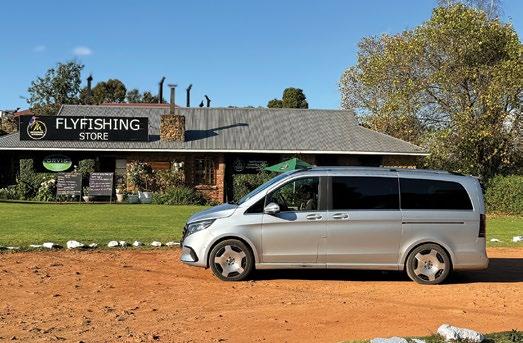
The V300d is proof that luxury and performance aren’t dictated by engine size. It’s an elegant, powerful, and deeply refined vehicle that seems equally at home cruising the Kruger as it does reverse-parked outside Konka.
Boot space is equally impressive. Even with the rear seats up, there’s 1 030L of space – plenty for all our gear. Fold the seats down and that jumps to a cavernous 4 630L. The electric tailgate even allows you to open just the window for easier access, which came in handy more than once.
Under the bonnet, the V300d is powered by a 2.0L turbocharged diesel engine, delivering 174kW and a healthy 550nm of torque. That power flows smoothly through a 9-speed automatic transmission to the rear wheels. Despite the V300d’s size, I averaged an impressive 8.2L/100km over the course of the week.
My few small gripes pale in the face of everything the V300d gets right. It’s a car that takes a well-deserved spot in my dream 7-car garage. Not just for the tech, the power, or even the badge, but because it represents something more. A reward for hard work. A symbol of success. A vehicle that, like the ML320 from 18 years ago, will live on in my memory.
• Price: R2 254 000
• Engine: 2.0L, four-cylinder, turbodiesel
• Transmission: 9-speed automatic
• Power: 174 kW @ 4 200 r/min
• Torque: 550 nm @ 1 600 r/min
• Driven wheels: Rear
• Claimed fuel consumption: 7.8L/100km
• Emissions: 205 g/km
• Top speed: 220 km/h


IMPRESS YOUR SAFARI COMPANIONS WITH THESE FASCINATING COLLECTIVE NOUNS FOR SOME ICONIC WILDLIFE OUT THERE!
You’re bouncing along on your game drive, the African sun doing its magic on the bushveld, when your guide suddenly hits the brakes. “Zebras, two o’clock!” Everyone’s scrambling for cameras and binoculars, but you? You’re cool as a cucumber, casually dropping, “Oh wow, what a gorgeous dazzle of zebras!” Boom – you’ve just become the safari superstar you never knew you wanted to be.
Welcome to the absolutely brilliant world of collective nouns, where animal groups get the most wonderfully weird names that’ll make you sound like a wildlife genius. These aren’t just fancy words to impress (though they definitely will); they’re your ticket to turning any game drive into an hilarious, unforgettable experience where you’re the guest everyone wants to sit next to.
A KETTLE OF VULTURES: When vultures soar in thermals, they’re called a kettle – a reference to the circular, bubbling motion they create in the sky. Spot them circling overhead, and you’ll never see them the same way again.

A CONGRESS OF HORNBILLS: The African redbilled hornbill, with its distinctive curved beak and dignified bearing, joins others of its kind in what’s called a congress. Disney fans will recognise these characterful birds as the real-life inspiration for The Lion King’s Zazu and, watching them hop about campsites with their rather officious demeanour, it’s clear why “congress” is such a fitting term for these birds.

A CONVOCATION OF EAGLES: When eagles gather, they form a convocation – a term that speaks to the reverence these majestic raptors command. Spot a pair of fish eagles soaring above the Kruger’s rivers, and you’re witnessing nature’s own parliament in session.
A CRASH OF RHINOS: Given the rhino’s reputation for charging their rivals, this
collective noun is delightfully appropriate. If you’re lucky enough to encounter the critically endangered black rhino or the nearthreatened white rhino in SA’s game reserves, referring to them as a crash adds gravitas to the sighting.
A MEMORY OF ELEPHANTS: Perhaps the most touching of all collective nouns, a memory of elephants speaks to these gentle giants’ renowned ability to remember. As you watch a matriarchal herd carefully navigate their young across a riverbed, this term takes on profound meaning.
A BLOAT OF HIPPOS: The seemingly lazy hippopotamus earns perhaps the most amusing collective noun. Whether you spot them wallowing in a waterhole or catch a glimpse of their pink bellies as they surface, a bloat of hippos never fails to raise a chuckle.

A COALITION OF CHEETAHS: The fastest land animal earns a rather formal collective noun. Male cheetahs often form coalitions for hunting and territory protection, making this term particularly fitting when you see these spotted speedsters together.
A JOURNEY OF GIRAFFES: There's something deeply poetic about watching a journey of giraffes move across the savannah, their elegant necks swaying in unison in a slow-motion, slightly lopsided ballet. Other collective nouns include a tower of giraffes – equally evocative, this time of their impressive height.

A SPIRAL OF KUDU: Named for the magnificent curling horns of the males, a spiral of kudu is perhaps one of the most visually descriptive collective nouns. These elegant antelopes with their distinctive white stripes are a photographer’s dream, especially when moving together through acacia woodland.
A CONFUSION OF WILDEBEEST: Perhaps there is no collective noun more apt than this one. Anyone who’s witnessed the Great Migration or watched wildebeest attempting to cross a river will understand why these ungainly antelopes earn such a befitting term. Their seemingly chaotic movements and indecisive behaviour make “confusion” absolutely perfect.
A CETE OF HONEY BADGERS: Though you’d be incredibly fortunate to spot even one honey badger (their fearless reputation is well-earned), multiple honey badgers form a cete. This rather obscure collective noun suits Africa's most fearless small predator – after all, nothing about the honey badger is conventional. An alternative collective noun for the honey badger is a “clan”.
AN OBSTINACY OF BUFFALO: Anyone who’s encountered African buffalo will appreciate this collective noun. These formidable creatures are notoriously stubborn and unpredictable, making obstinacy a wonderfully apt description.
A SOUNDER OF WARTHOGS: These endearingly ugly members of the pig family earn their collective noun from their tendency to make a noise. A sounder of warthogs perfectly captures their somewhat chaotic family dynamics.
A BUSINESS OF MEERKATS: Perhaps the most delightfully corporate of all collective nouns, a business of meerkats seems perfectly suited to these industrious little creatures with their organised sentry systems and efficient burrow networks.
A PRICKLE OF PORCUPINES: The obvious collective noun for porcupines never fails to amuse. These spiky nocturnal creatures are more commonly heard than seen, but if you manage to spot them together, you’ll have the perfect word ready – and it’s guaranteed to raise a smile.
Next time you’re on safari – exploring the vast expanses of Kruger National Park, the malaria-free Eastern Cape reserves, or the pristine wilderness of KwaZulu-Natal – remember that wildlife viewing is about more than just ticking animals off your Big Five list. It’s about connecting with nature’s poetry, and these collective nouns are your vocabulary for that conversation. Share them with your fellow travellers, impress your guide, and watch as a simple game drive transforms into fun conversation and edutainment that might just connect a disparate group of tourists. After all, there’s something rather


magical about watching a journey of giraffes while knowing you’re not just witnessing wildlife in action, but living language too. Your safari buddies will remember not just the incredible sightings, but also the person who, as a laugh, taught them that a group of rhinos is called a crash. And that knowledge will travel with them long after they’ve returned home.







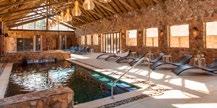


BOOK A DAY TRIP OR A LUXURY OVERNIGHT BIG 5 SAFARI ADVENTURE AT MONT ECO PRIVATE GAME RESERVE IN THE WESTERN CAPE, JUST 2 HOURS FROM CAPE TOWN.
Feeling jaded? Looking to find serenity and perhaps reawaken that sense of wonder?
Look no further than Mont Eco Private Game Reserve in the heart of the enchanting Klein Karoo, where golden light glances off stark, untamed landscapes, time seems to slow down and elemental nature and supreme luxury co-exist in glorious harmony.
Here, expert rangers will reveal to you the hidden poetry of the Karoo: giraffes gliding across the veld, elephants traversing ancient pathways… and the spirit of Africa pulsing in every rustling leaf and distant roar. Ensconced in soft blankets and hooded ponchos provided by Mont Eco, you’ll explore in comfort, surrounded by the vastness that seems to stretch beyond the horizon.
As dusk settles, you’ll retreat to your exquisite sanctuary – a haven of peace and refinement, where nature’s whispers drift through elegantly appointed rooms. Every detail is crafted for comfort, every space infused with tranquillity, with impeccable service that speaks of true hospitality.
Indulge in culinary artistry inspired by the Karoo’s rich flavours. Every meal is a celebration of the senses. At Mont Eco, we offer more than a getaway – we create
moments that linger long after you depart. This is a place where memories are woven into the very fabric of the land. Come, let the wild embrace you. Let Mont Eco awaken your soul.
Mont Eco Game Reserve is one of the rare Big 5 game lodges within the Western Cape, offering guests a quintessential safari experience on the slopes of the magnificent Langeberg Mountain range. Kingsley Lodge, on the banks of a seasonal riverbed within the Reserve, is the main lodge, and features various communal spaces, diverse dining options, and seven modern and spacious suites. The interior design boasts unique textures and colours, including handcrafted doors, mosaic murals, and subtle eclectic elements to evoke the vibrant spirit of Africa.
A combination of stone, ceramics, wood, and glass gives the lodge a contemporary style,with large stacking glass doors seamlessly connecting the indoors to the outdoors. The central area is a welcoming space for dining as well as lounging at the swimming pool, which offers spectacular views. Unwind on the expansive deck or in the intimate lounge, enjoy a wine-tasting experience from the private cellar, or immerse yourself in the serene sounds and fragrances of the Karoo.

Each game drive brings a new experience and opportunity as the rangers traverse the roads through the bush, valleys and mountains looking for the elusive leopard. Visit ancient riverbeds as they wind through the fringe of acacia trees lining a wooded wonderland in the shadow of the Langeberg’s towering cliffs. Your guide will share their deep understanding of this unique area and the symbiotic relationships that make up the unique ecosystem that is the Klein Karoo.
Game drives are conducted twice a day depending on the season: early morning, as the sun slowly starts to cast its blush on the mountains, and just as the sun starts dipping towards the horizon before sunset. Included in all our accommodation packages, this amazing experience is not to be missed.
Each game drive brings a new experience as you travel through the bush to catch sight of the African Big 5 – lion, leopard, elephant, rhino and buffalo. For more info on our day safaris, enquire with us directly. Game drives for day visitors are subject to availability.
Wanna take a walk on the wild side? Go off the beaten track and immerse yourself in the raw beauty of Mont Eco’s landscapes.
Few places on earth offer the virtually elemental landscape and tranquility found at Mont Eco Private Game Reserve. Each step of an unforgettable bush walk guided by our experienced rangers will reveal the
hidden wonders of the Klein Karoo. Whether you prefer a leisurely stroll through ancient river courses, or a more adventurous hike to explore fossil-rich sites and ancient San rock art, Mont Eco rewards you with spectacular vistas and unique insights into South Africa’s natural heritage. It’s an intimate, up-close encounter with Africa’s wildlife and diverse flora, enhancing your connection with nature as you discover the fascinating stories left behind in the landscape. This exclusive adventure offers a truly immersive safari experience beyond traditional game drives.
NB: Guided bush walks are an exclusive experience reserved for guests staying overnight at Mont Eco Private Game Reserve. These immersive adventures are included in our accommodation packages and are not available to day visitors.

Email: reservations@montecogamereserve.co.za
Reservations: +27 (0) 71 410 9716
Kingsley Lodge: +27 (0) 23 111 0014
Location: Driekuilshoogte Road, Montagu, Western Cape, South Africa

BY ANDRE STEYN
AFTER EXPLORING PRIVATE GAME RESERVES ACROSS SOUTH AFRICA, I’M UTTERLY CAPTIVATED BY WHAT THESE EXCLUSIVE WILDERNESS SANCTUARIES OFFER. HERE’S WHY THEY’VE COMPLETELY WON ME OVER.
In a private reserve, I once sat alone with a lion pride, just me, the guide, and the silence of the bush. No engine queues. No jostling for space. Rangers here can go off-road, tracking fresh prints through thick scrub to bring you face-to-face with a rhino, an intimate encounter that feels utterly authentic.
Then there are the night drives. I’ve watched hyenas emerge under moonlight, owls glide low, and bush babies blink from the trees. These nocturnal adventures reveal an entirely different world, where the bush comes alive with the sounds and movements of animals you’d never experience during daylight hours. And walking safaris? Absolutely unmatched. Tracking zebra on foot, every snap of a twig feels electric.
The lodges elevate the experience to extraordinary
levels. Picture breakfast with elephants grazing outside your window, or sundowners beside a watering hole as the wildlife gather for evening drinks. These aren’t just accommodations; they’re immersive experiences that put you right in the heart of the wilderness.
The personalised attention is remarkable. Say you’re passionate about birds; your guide might spend hours helping you spot a rare hornbill, tailoring the entire safari to your interests. Once, I even joined rangers on patrol, checking up on cheetahs and getting a handson glimpse into vital conservation work.
After countless safaris, private reserves consistently deliver the most personal, immersive, and aweinspiring experiences. If you want wilderness adventure with unparalleled access, intimacy, and that special wow-factor, this is where you’ll find it.

In a private reserve, I once sat alone with a pride of lions – just me, the guide, and the silence of the bush.”





LOOKING TO ESCAPE THE FESTIVE SEASON STRESS AND MADDING CROWD? RADISSON BLU HOTEL, DURBAN UMHLANGA WILL DELIVER ALL THE FESTIVE CHEER WITHOUT THE AGGRO…

The festive season in Durban is pure magic –golden beaches, sparkling ocean views, and that unmistakable summer energy. At the heart of it all is Radisson Blu Hotel, Durban Umhlanga, perfectly located next to Oceans Mall and overlooking the warm, silky Indian Ocean. Here, luxury meets holiday cheer for an unforgettable seasonal escape.
From the moment you arrive, the spirit of the season surrounds you from the lobby’s elegant décor and towering Christmas tree, to the gorgeous FireLake Restaurant. Every detail is designed to make the holidays truly special, whether you’re planning a sunsoaked staycation, a coastal getaway, or a festive feast.
On that point, festive dining is definitely a highlight at Radisson Blu. On Christmas Eve you can gather loved ones for a sumptuous 3-course plated meal with seasonal flavours. Christmas Day Lunch boasts a lavish buffet feast perfect for families, complete with all your festive favourites. On 21 December, you can indulge in their elegant Festive High Tea – a decadent afternoon of sweet treats, savoury bites, and sparkling moments. And for the ultimate celebration, New Year’s Eve at FireLake promises live entertainment, gourmet dining, and sweeping ocean views to welcome 2026 in unforgettable style.
The hotel offers dedicated kids’ holiday activities during the festive period, keeping little ones happily
Step outside and the best of Umhlanga awaits – from the vibrant Umhlanga Village and scenic Promenade to Oceans Mall’s high-end shopping and dining.”


entertained while parents get some much-needed R&R poolside.

And for businesses or social groups, our year-end packages – available through October, November, and December – offer the perfect way to celebrate with colleagues or friends in a stylish, memorable setting.
Step outside and the best of Umhlanga awaits – from the vibrant Umhlanga Village and scenic Promenade to Oceans Mall’s high-end shopping and dining. After a day of festive fun, retreat to your spacious ocean-view room, unwind on the pool deck, or sip on seasonal cocktails as the sun dips below the horizon.
Whatever brought you to the Radisson Blu – a celebration, a date, or simply a need to recharge, Radisson Blu Hotel, Durban Umhlanga is your go-to destination for a memorable festive season.
For bookings or more information: +27 31 575 8500 info.durban.umhlanga@radissonblu.com
Step into elegance at our 17th-Century Cape Dutch guest farm. This lovingly restored 17th-century Cape Dutch manor house in the Cape Winelands features 13 luxurious rooms and suites, each blending heritage charm with contemporary comfort; timeless beauty and modern luxury. Surrounded by beautifully maintained gardens, our estate provides a picture-perfect setting for your dream wedding, whether you’re after a rustic, elegant, or fairy-tale storybook celebration.
-34°03'61.60"S l 18°80'21.35"E +27 21 842 3264 / +27 61 725 9120
info@vredenburgmanor.co.za www.vredenburgmanor.co.za



Planning a weekend getaway? Le Pommier Wine Estate on Helshoogte Pass in the Cape Winelands offers warm hospitality, estate-grown wines, country-style accommodation, a cosy restaurant, and a scenic wedding and function venue. With its truly picturesque setting, it’s become a firm favourite for wine tastings, relaxed getaways, family outings, and memorable celebrations.
-33°91'90.1 S l 18°92'79.7 E
+27 (0)21-8851269
marketing@lepommier.co.za www.lepommier.co.za
At Kleine Zalze, excellence begins in the vineyard. Each wine reflects our deep respect for nature, tradition, and innovation. Dine at our restaurant, led by Nic van Wyk, where seasonal, locally sourced ingredients shine in every dish. Whether tasting under the vines or enjoying a relaxed lunch, every experience is designed with intention – true to our Stellenbosch roots and made for those who value quality.
-33°94'82.9 S l 18°85'41.0 E
+27 (21) 880 8167
restaurant@kleinezalze.co.za www.kleinezalze.co.za




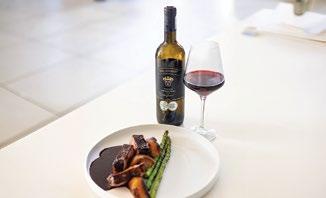
The Franschhoek Motor Museum offers visitors a special opportunity to look back at more than 100 years of motoring history with its unique and exciting collection of vehicles, motorcycles, bicycles, and memorabilia in the magnificent setting of the L’Ormarins Wine Estate.
S -33°87'94.3 l E 19°00'29.5 +27 (0)21 874 9002 fmm@fmm.co.za www.fmm.co.za


Need a recharge? There’s nothing like the wide open Lowveld skies to get you back to your best. At ANEW Resort White River Mbombela, every stay invites you to slow down and soak it all in. Lounge poolside by day and sip on sundowners under the trees at dusk. And with the Kruger less than an hour away, you can throw in a lovely adventure too.
S -25°34'61.28 l E 31°00'82.28 +27 (0)13 750 7000 whiteriverres@anewhotels.co.za www.anewhotels.com/hotels/white-river

Turn every meal into a celebration with the bold charm of Niel Joubert’s Cabernet Franc, proud winner of a Michelangelo Platinum Award. Smooth tannins and rich spice make this elegant red a beautiful complement to juicy red meats and roasted vegetables. Taste the pride. Taste the passion... Taste Niel Joubert.
S -33°83'13.0 l E 18°89'99.4 +27 (0)21 857 5419 wine@nieljoubert.co.za www.nieljoubert.co.za

The first Jordan wines were created in 1993 by husbandand-wife winemaking team, Gary and Kathy Jordan, in their state-of-the-art cellar. Today, the estate in scenic Stellenbosch has transformed into one of the leading estates in the country and features a wine tasting centre, rolling lawns, luxury accommodation, and two world-class restaurants where you can enjoy fine Cape wine and local cuisine all while feasting your eyes on spellbinding views of the vineyards.
S 33°94'30 l E 18°74'42 +27 (0)21 881 3441 reservations@jordanwines.com www.jordanwines.com


Tucked away in the deep and quiet ambit of nature, is Sungubala Eco Camp. Overlooking a peaceful valley on a secluded mountain farm, here you immerse yourself in the purity of wild spaces. It’s for those who enjoy preparing their own meals, hiking and relaxing in the simplicity of natural settings.

S 28°62'36.87 l E 28°96'49.14
+27 (0)63 030 7161 info@sungubala.co.za www.sungubala.co.za
Ever wondered how tequila is made? Visit us in Graaff-Reinet, the heart of Africa’s agave plantations and home to our authentic, Mexican regulatory standard, tequila-making distillery. Expert guides will take you through the entire process: from steam cooking (think flavour and complexity) through to the traditional ageing methods. Plus, you’ll get to enjoy a tasting of a selection of our premium 100% agave spirits. Booking is essential.
S 32°26'41.9 l E 24°54'99.1
+27 (0)79 141 9202 (WhatsApp) info@daroccacraft.co.za www.daroccacraft.co.za




Peter Falke Wines blends German precision with French elegance in the heart of Stellenbosch’s “Golden Triangle”. The estate harmonises heritage and modernity. Led by winemaker Werner Schrenk, its award-winning portfolio – including the Blanc de Noir, Chardonnay, Cabernet-led blends, and the 2025 Cabernet Sauvignon Challenge Trophy winner – offers an unforgettable lifestyle experience.
S 34°0'1.86 l E 18°50'21.05
+27 (0)21 881 3677 tasting@peterfalkewines.co.za www.peterfalkewines.com






AS THE SUN DIPS BEHIND THE JOZI SKYLINE, A DIFFERENT KIND OF ENERGY RISES. FROM NEWTOWN’S INTIMATE CULTURAL ENCLAVES TO THE EXPANSIVE STAGES OF THE SANDTON CONVENTION CENTRE, THE CITY’S JAZZ SCENE IS NOT MERELY SURVIVING; IT’S THRIVING, HONOURING ITS RICH PAST WHILE SHAPING AN AUDACIOUS FUTURE
A living legacy
To appreciate Johannesburg’s jazz renaissance, one must first acknowledge the legends who laid its foundation. Icons like Hugh Masekela, Miriam Makeba, and Abdullah Ibrahim didn’t just perform; they gave voice to a nation. Their influence remains deeply embedded in the rhythms and compositions of today’s leading artists. Pianist Bokani Dyer exemplifies this new era. Winner of the 2011 Standard Bank Young Artist Award for Jazz, Dyer continues to explore themes of unity, identity, and nation-building. His 2023 album, Radio Sechaba, captures the complexities of post-Apartheid South Africa through richly layered, contemporary sounds.
The sound of today
Though some historic venues have closed, Johannesburg’s jazz spirit lives on in storied spaces like Niki’s Oasis in Newtown; still an essential listening room for fans seeking live upright bass and classic South African fare. Over in Orange Grove, the Radium Beerhall continues its legacy with the city’s longestrunning monthly jazz session, held every first Sunday of the month for over 25 years.
A new generation emerges Johannesburg’s jazz evolution is fuelled by a bold, genre-blending generation. Recent collaborations, such as the Johannesburg Philharmonic Orchestra’s Symphonic Jazz Festival, brought together artists like Siyabonga Mthembu, Siya Makuzeni, and Bokani Dyer, mixing classic compositions from Hugh Masekela and Abdullah ‘Dollar’ Ibrahim with works by contemporary


talents including Benjamin Jephta and the late Feya Faku.
The compilation Indaba IS, curated by Thandi Ntuli and Mthembu, offers a snapshot of the scene’s creative depth. Featuring acts like The Ancestors and Mthembu’s The Brother Moves On, it’s a testament to the city’s fearless innovation. These artists don’t just reinterpret jazz; they expand it, drawing from rock, traditional rhythms, and global sounds.
Each September, the Standard Bank Joy of Jazz Festival transforms the Sandton Convention Centre into a global jazz haven, featuring more than 50 artists across five stages. With performances by artists from the African continent, Europe, Asia, and the Americas, the festival embodies jazz as a truly international language.
Looking ahead, the Music and Lifestyle Expo 2025 promises to blend live music with cultural entrepreneurship, food, and education; positioning Johannesburg as a multifaceted creative capital.
What’s unfolding isn’t just a musical trend; it’s a transformation in how Johannesburgdefines itself.”
More than a resurgence, Johannesburg’s jazz movement is a reinvention. It fuels urban regeneration, generates employment, and draws in tourists seeking a deeper cultural immersion. It also serves as a platform for social commentary, tackling identity, justice, and pride through melody and improvisation.
What’s unfolding isn’t just a musical trend; it’s a transformation in how Johannesburg defines itself. In clubs and festivals, on stages and sidewalks, jazz in the City of Gold is not only echoing history, but shaping the future.
As the last notes drift through the night, the music lives on in conversations, jam sessions, and shared dreams. This is more than a revival. It’s a renaissance that proves jazz in Johannesburg doesn’t just endure; it evolves, inspires, and connects the world through a uniquely South African lens.
Peaches-and-cream with citrus and orange blossom aromas open to rich, aromatic layers. The palate is plush and textured, with a mineral core, lively acidity, and a smooth, creamy finish.

Dark chocolate, mineral, and tobacco notes frame rich mulberry, cassis, and dark berries. Plush chalky tannins and vibrant texture lead to a long, creamy, and flinty finish..

A bone-dry, Provence-style rosé (Sangiovese, Grenache, Shiraz) with a light blush hue. Cherry blossom, strawberry, and citrus aromas lead to a crisp, refreshing finish.


A must for any occasion; crisp green apples, silky mousse, and a hint of brioche. Perfect with salmon and dill risotto.


Seductive and sultry, with Stollen, dried flowers, dark berries, and molasses. Velvety and rich; perfect with Youvetsi and fireside conversation.
A vibrant Merlot-led blend with Shiraz and Sangiovese, offering floral notes, red berries, and gentle spice. The elegant 2020 vintage brings soft tannins and easy drinkability.

Deep ruby red with vibrant raspberry, cherry, and hints of tea, tobacco, and oyster shell. The palate is fresh with smoky oak, vanilla, and fine tannins. Elegant, lingering finish. Enjoy with pasta, tandoori chicken, or lamb chops. Drink by 2029.

Bright golden with aromas of pear, peach blossom, lime, and caramelised oats. Full-bodied yet crisp, with apple, citrus, crème brûlée, and roasted almonds. Refreshing finish. Great with grilled fish, Alfredo pasta, salads, and mild curries.
Vibrant charcoal red with viscous legs. Grenache offers sweet lilies and rose-petal Turkish delight, Carignan brings plush black currant and blueberries, and Shiraz adds velvety red berries and soft spice. Smooth, plush palate with red cherry, plum, subtle spice, and roasted coconut. Perfect with grilled steak and mushrooms or slow-cooked pork belly with root veggies.


Delicate blush pink with aromas of crushed strawberries, nectarine, rose petals and Turkish delight. Crisp pomegrante freshness with stylish silkiness on the palate

Falke

Valdu Charron Black Countess 2022
Refined aromas of citrus, white peach, apricot and baked quince. Warm butterscotch and vanilla on the palate with toasted almonds, leading to a clean, creamy and elegant finish.
Our signature blend creates an elegant wine with rich, dark fruit and sweet berry flavours complemented by firm tannins and good concentration.

BY HESTER KLEYNHANS
TUCKED IN THE ROLLING HILLS OF THE OVERBERG, BARTON VINEYARDS OFFERS LUXURIOUS VILLAS, UNFORGETTABLE WINE TASTINGS, AND SOULFUL SCENERY.
South Africa is spoiled for choice when it comes to wine regions, and I’ve been lucky enough to explore most of them. But this time, I stumbled upon the Overberg’s bestkept secret: Barton Vineyards, tucked away in the rolling hills of Botrivier.
A hidden gem
Barton has been around for decades, but I only discovered it recently and from the moment I arrived, I was hooked by the Barton magic. I was warmly welcomed by the ever-charming winemaker, Kobie Viljoen, who whisked me off to my accommodation for the weekend.
The farm has five spacious villas and when I say spacious, I mean let’s rename them mansions. I stayed in a villa called Hammerkop, and it blew me away. Think high ceilings, endless space, and every creature comfort you could dream of: a fireplace, a private pool, a braai area, and even a wood-fired hot tub.
Friday night kicked off with a wine-tasting hosted by the bubbly GM of Barton Vineyards, Jurne, alongside Kobie himself. The evening was filled with great conversation, excellent company, and truly exceptional wines. Kobie even treated us to a sneak peek of his upcoming creations, and before I knew it, we were chatting and sipping late into the night.

The majestic Hemel-en-Aarde Valley Saturday morning, I woke up with what can only be described as the wrath of the grapes. Thankfully, a brisk 30-minute walk through Barton’s protea fields cleared my head before I headed off for a Bouchard Finlayson experience.
Nestled in the gorgeous Hemel-en-Aarde Valley, this boutique winery completely stole my heart. I was welcomed by Mireille Coetzer, Marketing manager for Bouchard Finlayson, and assistant winemaker Barend Coetzer for a Women’s Day wine tour that included superb wines, a crackling fire, live music, and the perfect charcuterie board.
Just when I thought I’d found my favourite wine, another would come along and steal the spotlight. In the end, two clear winners stood out for me: the Crocodile’s Lair Chardonnay and the Galpin Peak Pinot Noir.
By the time I returned to Barton, the rain was pouring down – just in time for the arrival of my family, who joined me for the rest of the weekend.


And honestly? The rain didn’t matter at all. With a roaring fire, a few rounds of dominoes, and glasses of Barton’s finest, we barely noticed the storm outside.
Barton Vineyards is more than just a wine estate – it’s a place where family and friends can gather, connect with nature, share a bottle (or two), and create memories you’ll want to relive again and again.
My Hester’s Wine Wagon adventure in the Overberg gets a solid 10/10. I’m already planning my summer return to Botrivier’s best-kept secret.



Two hundred hectares of natural beauty, with 33 of those dedicated solely to vineyards… Sound like heaven? You bet! That’s Barton Vineyards and Villas, a tranquil sanctum on the edge of the virginal Kogelberg Nature Reserve. Set against the backdrop of Babylon Mountain, this remarkable estate delivers a subtle refined charm, offering a combination of luxe accommodation, awardwinning winemaking and the opportunity to explore the stunningly beautiful surrounds.
The farm proudly produces its own premium wines on site, from vine to bottle. Under the skillful guidance of acclaimed winemaker Dewald Grobler, Barton has become famous for producing wines that reflect the unique terroir of this region.
Signature varietals include their robust Shiraz, the elegantly crisp Merlot Rosé, and the historic Old Vine Chenin Blanc, all harvested from vines planted in 1983. Barton’s Cabernet Sauvignon is another standout, its rich, full-bodied notes encapsulating the essence of the region’s soils and climate.
Beyond the wine, Barton offers guests a truly immersive experience. The estate is home to five luxurious Tuscan-style villas, each designed for luxurious comfort and privacy. These villas sleep between 4 and 10 guests and are equipped with private hot tubs and swimming pools perfect for both romantic escapes and group getaways.
The estate also boasts a well-appointed tasting room and wine cellar where guests can savour Barton’s finest vintages. For those seeking some R&R and a connection with nature, Barton Vineyards and Villas offers scenic walking trails, soothing sundowner spots, and a designated picnic area for leisurely afternoons under the oaks.
Wildlife abounds on the property. It is not uncommon to spot small antelope, and there’s abundant birdlife – you might even spot the graceful blue crane, the national bird of South Africa. The estate’s proximity to the Kogelberg Nature Reserve, one of the most biodiverse places on earth, further enriches the experience for nature lovers and adventurers alike.
It’s a mere stone’s throw from Botrivier and the Overberg region, so a trip to Barton Vineyards and Villas is not just a destination – it’s a journey into the heart of South Africa’s wine country as well as the Cape’s renowned coastal and mountain attractions. Whether you’re here to indulge in fine wine, immerse yourself in dramatic landscapes or simply unwind in luxury, Barton delivers an unforgettable experience rooted in authenticity, elegance, and natural wonders.
For more info, call 082 379 2769, or 028 284 9283, email info@bartonvineyards.co.za or visit www.bartonvineyards.co.za


A gem so rare it is limited to a single generation.
The geological discovery of tanzanite has been described as a geological phenomenon, giving rise to tanzanite’s unparalleled scarcity. In appreciation of this captivating gem, The Diamond Works tells the historic tale of tanzanite, showcasing a firsthand cutting and polishing demonstration and wide range of the most elegant tanzanite jewellery pieces – offering the opportunity to take home the Essence of Africa.
thediamondworks@tjd.co.za www.thediamondworks.co.za

IMAGINE STANDING WHERE THREE COUNTRIES MEET, WATCHING ELEPHANTS CROSS INVISIBLE BORDERS AS THEY FOLLOW ANCIENT MIGRATION ROUTES THEIR ANCESTORS HAVE USED FOR THOUSANDS OF YEARS. WELCOME TO THE GREAT LIMPOPO TRANSFRONTIER CONSERVATION AREA (GLTFCA) – NEARLY 10 MILLION HECTARES OF WILD AFRICA, WHERE CONSERVATION DREAMS HAVE BECOME REALITY.

This isn’t just another game reserve. It’s one of the world’s most ambitious conservation success stories, where nature reigns supreme and travellers become part of something truly extraordinary.
Wild animals don’t carry passports. They follow their instincts through landscapes that have always been home, regardless of human-drawn boundaries. The GLTFCA made this possible again, linking Mozambique’s Limpopo National Park with South Africa’s legendary Kruger National Park and Zimbabwe’s spectacular Gonarezhou National Park.
500 bird, and at least 2000 plant species. From mopane woodlands in the north to seasonally flooded grasslands in the south, every ecosystem tells a different story.
The Big Five roam here in numbers that will leave you speechless. But there’s something even more special – the Kruger National Park protects around 400-500 African wild dogs (Lycaon pictus), one of the continent’s most endangered predators. Spotting these incredible hunters is the wildlife equivalent of winning the lottery.

Mozambique: the phoenix rises
The dream became reality on 9 December 2002, when three presidents signed a groundbreaking treaty. Today, the core area covers 37 572km2. As part of the Transfrontier Conservation Area visionary movement across southern Africa, the GLTFCA proves that when nations work together, wildlife wins.
The GLTFCA is nature’s masterpiece. Vast savannahs stretch to endless horizons, split dramatically by the Lebombo Mountains rising 500 metres skyward. Four mighty rivers – the Limpopo, Olifants, Save, and Komati – carve through this wilderness, creating oases that attract thousands of animals.
This isn’t just beautiful, it’s biologically incredible. Three distinct biomes create homes for 147 mammal species, as well as 116 reptile, 49 fish, 34 frog, over
Mozambique’s Limpopo National Park started as a million-hectare hunting concession, with barely any roads. Through an incredible partnership between the Mozambican government and the Peace Parks Foundation, it has been transformed into a conservation jewel. The Pafuri and Giriyondo Tourist Access Facilities now seamlessly connects visitors between South Africa and Mozambique.
But here’s the amazing part: Wildlife is being reintroduced, and population densities are being enhanced through large-scale translocation efforts.
The diverse landscapes will blow you away. Vast sandveld covered in mopane and ironwood, the dramatic Shingwedzi River Valley dwarfed by incredible cliffs, and the popular Massingir Dam where tiger fishing enthusiasts can test their skills against these feisty fighters.
Zinave National Park, covering 400,000 hectares, offers the ultimate off-the-beaten-track experience. Since 2017, an ambitious rewilding programme has been reintroducing the Big Five. Best of all? It’s perfectly positioned for epic bush-to-beach adventures to the stunning Vilanculos-Bazaruto Archipelago or Maputo National Park in Southern Mozambique.
South Africa: the Kruger’s legendary magic Kruger National Park needs no introduction; it’s pure African magic. Established in 1898, this 20 000km2 wilderness attracts over 1,5 million visitors annually, and with good reason.
The numbers are staggering: 1 600 lions, over 30 000 elephants, 48 000 buffalo, and over 1 000 leopards call this place home. But numbers don’t capture the spine-tingling moment when a massive elephant bull approaches your vehicle, or the heart-stopping thrill of watching a leopard emerge from the shadows.
Zimbabwe’s Gonarezhou National Park – “The Place of Elephants” – is where adventure seekers find their paradise. This 500 000-hectare wilderness hosts over 11 000 elephants and offers some of Africa’s most untamed landscapes.
The star attraction? The iconic Chilojo Cliffs; spectacular 200-metre sandstone towers rising like ancient cathedrals above the Runde River. Standing atop these cliffs at sunset, watching elephants gather at the river below, is just pure African magic.
The Gonarezhou Conservation Trust (GCT)
In 2017, the Gonarezhou Conservation Trust was established as an innovative co-management partnership between the Zimbabwe Parks and Wildlife Management Authority (ZimParks) and the Frankfurt Zoological Society (FZS). This model was designed to ensure the long-term protection and sustainability of the park by combining the strengths of a national authority with the expertise and resources of an international conservation NGO.
Through the GCT, the park benefits from enhanced anti-poaching operations, ecological monitoring, community engagement, and sustainable tourism development. This partnership represents a progressive approach to conservation in Zimbabwe, aiming to secure Gonarezhou as a thriving wilderness for both people and wildlife.
The GLTFCA pulses with Shangaan culture, which
predates the European arrival by centuries. The Pafuri area, where the Limpopo and Luvuvhu rivers meet, remains sacred to the Makuleke and Sengwe clans, who hold traditional authority across all three borders.
The Makuleke people’s story is particularly inspiring. After being displaced from their ancestral lands in 1969, the community has since reclaimed the northern reaches of Kruger National Park, now known as the Makuleke Contractual Park. Managed in partnership with South African National Parks (SANParks), this innovative model combines conservation with community empowerment. Today, the Makuleke stand as a powerful example of how people and nature can thrive together; a success that is inspiring similar initiatives across the Greater Limpopo Transfrontier Conservation Area (GLTFCA).
Ready for the ultimate African adventure? The GLTFCA offers experiences impossible anywhere else. Plan your own Great Limpopo Cross-Border 4x4 Trails –challenging routes through three countries, with river crossings and terrain that’ll test your skills and reward your spirit.
Adventure junkies can choose from multiple 4x4 routes through the TFCA, or experience guided walking safaris in Kruger and Gonarezhou National Parks.
From luxury safari lodges to wilderness camping under

star-filled skies, the GLTFCA caters to every traveller. Kruger offers 27 camps ranging from basic rest camps to luxury bush lodges, while private reserves like Sabi Sands provide ultra-luxury experiences.
In Mozambique, choose from community-focused Covane Lodge, where every dollar benefits local villagers, basic camping at Massingir Dam, or rustic wilderness camps. Zimbabwe offers everything from remote bush camping in Gonarezhou to the ultra-luxury Singita Pamushana Lodge and Chilo Gorge Luxury Safari Lodge.
Conservation heroes
This isn’t just tourism, it’s conservation in action. Anti-poaching efforts use cutting-edge technology, international cooperation, and community engagement. Local communities directly benefit from tourism revenue, creating powerful incentives for conservation. It’s a model that’s changing Africa.
Your African adventure awaits
The GLTFCA represents more than a destination; it’s a glimpse into Africa’s future where conservation, communities, and tourism work together. Whether you’re photographing elephants against a mountain backdrop, learning traditional crafts from local artisans, or simply sitting by a campfire under the Southern Cross, you’re part of one of conservation’s greatest success stories.
Access is easier than ever. Fly into Johannesburg, Cape Town, Maputo, or Harare, then connect to regional airports like Kruger Mpumulanga International, Skukuza or Hoedspruit in South Africa, or Buffalo Range in Zimbabwe.
The Pafuri and Giriyondo border crossing offers seamless 4x4 access between South Africa and Zimbabwe for properly prepared travellers. For the more adventurous, the SangoChiqualaquala border offers a pontoon across the river and the new pilot tourism
access facility provides a direct link between Kruger and Gonarezhou National Park for overland explorers (pre-booked, scheduled, and 4x4 only).
Here, where ancient migration routes have been restored and communities find new hope through conservation, you’ll discover something profound. Like the elephants and buffalo that once again roam these plains freely, you’ll find your own sense of freedom in this vast landscape where nature knows no boundaries.
The GLTFCA isn’t just about protecting wild spaces; it’s about preserving something essential for the human spirit. Come and be part of the story.
Traveller Highlights (at a glance)
Chilojo Cliffs: incredible sandstone mountains (landscape)
Malilangwe Conservation Area: Kambako Living Museum (cultural)
Samalema Gorge: (natural attraction)
Zinave: route for 4x4 travellers to the beaches of Bazaruto (bush & beach)
Banhine National Park: unique wetlands (prolific birdlife)
The Sengwe-Tshipise Corridor: gateway to adventurewhere three countries meet Thulamela: linked to the ancient Kingdom of Great Zimbabwe (cultural)
Tsendze Rustic Campsite: 4x4 camp (accommodation) Immersive Cultural Experiences: (community)
Shingwedzi Cliffs: 4x4 route (natural attraction)
Massingir Dam: Excellent tiger-fishing (activity)
The magnificent beaches of Mozambique: (bush & beach)

YOU’RE CRUISING THROUGH A BREATHTAKING LANDSCAPE, WINDOWS DOWN, MUSIC UP, WITH THE SUN BEATING DOWN ON YOUR ADVENTURE-BOUND SPIRIT. BUT WHILE YOU’RE SOAKING UP THOSE MEMORABLE MOMENTS, YOUR SKIN IS TAKING QUITE THE BEATING. ENTER SPF – YOUR TRAVEL COMPANION
Sun Protection Factor (SPF) is essentially your skin’s bodyguard against harmful ultraviolet (UV) rays. Think of it as an invisible shield that deflects the sun’s attempts to turn you into a red-faced English tourist (love you, Brits – no offence). Did you know that the number after SPF indicates how much longer you can stay in the sun without burning compared to unprotected skin? In other words, SPF 30 means you can theoretically stay out 30 minutes longer than you would without it.
But here’s the thing – and this is where many road trippers go wrong – higher doesn’t always mean better! SPF 30 blocks about 97% of UVB rays, while SPF 50 blocks 98%. The difference? A measly 1%. So save your money and stick with Factor 30 as your baseline.
Road trip reality check
Your car windscreen offers some protection against UVB rays, but UVA rays – the sneaky ones that cause premature ageing and can penetrate glass –are still getting through! That’s why truck drivers often show more sun damage on their right arm. Don’t let this be your souvenir from that epic

Garden Route adventure. The golden rule for any outdoor escapade is simple: if you can see daylight, you need SPF. Even on overcast days, up to 80% of UV rays can penetrate clouds. That moody, dramatic sky you’re photographing in the Drakensberg? It’s still serving up UV rays.
Do I need to wear sunscreen indoors?
Absolutely! Ever felt the heat emanating from your laptop screen after bingeing Netflix? That’s low-dose UVA exposure. New research has increasingly shown that you can incur UVA damage from artificial light sources such as fluorescent lighting, LED screens, and digital devices. Prolonged exposure to blue light (HEV light) and low-dose UVA from computer and phone screens may exacerbate pigmentation concerns and oxidative stress, particularly if you’re prone to brown or grey patches on your skin (melasma) or are darker-skinned. Over time, unprotected exposure accelerates visible signs of ageing such as fine lines, uneven texture, and hyperpigmentation. More concerningly, it increases the risk of actinic keratosis (a precancerous condition) and various forms of skin cancer, including melanoma.
Application station
Here’s where most people mess up spectacularly. You need about a half teaspoon of sunscreen just for your face and neck. For your entire body, you’re looking at roughly 35ml! Most people use about a quarter of the recommended amount, which dramatically reduces protection. Don’t forget the commonly missed spots: ears, back of the neck, tops of feet, and that strip of scalp where your hair parts. These areas are sun damage hotspots that’ll remind you of your negligence long after your trip ends. Reapply after every two hours spent outdoors or immediately after swimming, sweating, or towelling off. Yes, even if the bottle claims to be waterproof – it’s more like waterresistant, and that resistance has limits.
Finding your perfect match
The best sunscreen is the one you’ll actually use consistently. Hate the greasy feel? Try a gel-based formula. Sensitive skin? Look for zinc oxide or titanium dioxide. Active outdoors? Waterproof formulations are the way to go.
Chemical sunscreens (containing ingredients like oxybenzone) absorb UV rays, while physical sunscreens (zinc oxide, titanium dioxide) reflect them. Both work effectively, so choose based on your skin’s preferences and sensitivities.
The bottom line
Your skin doesn’t take a holiday just because you do. Daily SPF application is the single most effective anti-ageing and skin-preserving habit you can develop. It’s never too late to start protecting what you’ve got, and every day you begin is a day closer to healthier skin.
Whether you’re chasing waterfalls in Mpumalanga or wine-tasting in Durbanville, make SPF your non-negotiable travel essential. Your future self – the one looking at photos from this trip 20 years from now – will thank you for it. Remember: there’s no such thing as a healthy tan, only varying degrees of skin damage. But there is such a thing as healthy, protected skin that lets you enjoy countless more adventures under the South African sun.


Neptune hotels has a portfolio of resorts located on Af rica’s most pristine beaches and safari properties that offer the highest level of luxury to showcase the natural beauty and hospitality of East Af rica




Neptune Beach Resor t: Located on the Nor th Coast of Mombasa, Bamburi Beach
Neptune Paradise Beach Resor t & Spa: Located on the South Coast of Mombasa, Diani Beach
Neptune Village Beach Resor t & Spa: Located on the South Coast of Mombasa, Diani Beach.
Neptune Palm Beach Boutique Resor t & Spa: Located South Coast of Mombasa, Diani Beach
Neptune Pwani Beach resor t & Spa: Located on the Nor th East Coast of Zanzibar, near Kiwengwa




Surrounded by lush vegetation, this Luxur y Tented Camp ensures a vibrant and green landscape all year-round, offering breathtaking views of the Mara Region plains.
Set in virgin Tanzanian bush in the Ngorongoro volcanic landscape, this all Suites wood log cabin style retreat is located a few steps f rom the Game Reser ve Gate and 20 minutes drive away f rom the Ngorongoro Crater
Nestled in the heart of the Masai Mara, immersed in the original bush among indigenous plantations and trees, the 20 Luxur y Tents are directly overlooking the Mara River, offering unforgettable safari experiences.
Discover our Lodge and Tented Camps and experience East Africa with our uniquely designed combinations of Luxury Safaris.
This is the untold story of Tanzania and Zanzibar: how monsoon patterns create an invisible thread connecting the timing of the Great Migration with the spice island’s agricultural cycles.
Understanding this connection transforms a visit to both destinations from a simple safari-beach combination into something far more meaningful; a journey that follows nature’s own calendar, revealing how climate patterns have shaped life across this region for millennia.
East Africa experiences two distinct monsoon seasons. The northeast monsoon (known locally as kaskazi)
arrives between November and March, bringing shorter rains and cooler temperatures. The southeast monsoon (kusi) dominates from April to October, delivering the region’s main rainy season followed by dry, windy conditions. These aren’t merely weather patterns; they’re the fundamental rhythm that governs everything from wildlife movements to agricultural practices, from fishing seasons to traditional sailing routes.
The Great Migration’s timing is intrinsically linked to rainfall patterns. Between December and March, following the arrival of the northeast monsoon’s short rains, approximately 500 000 wildebeest calves are born in the southern Serengeti and Ngorongoro Conservation Area.

This is no coincidence; fresh grasses after the short rains offer ideal nourishment for pregnant and nursing wildebeest. The southern plains become a vast nursery where young animals build strength before the long journey north. These aren’t merely weather patterns; they’re the fundamental rhythm that governs everything…
Research has shown that wildebeest can detect rainfall from distances of over 50 kilometres, following these weather patterns with remarkable precision. Their movements north typically begin in April as the southeast monsoon brings the long rains, creating the lush grasslands that will sustain the herds during their epic journey.
before the southeast monsoon rains begin. Cardamom plants thrive in the humid conditions created by northeast monsoon winds, while the cinnamon harvest timing depends on optimal moisture levels.
Traditional spice farming techniques developed over centuries reflect a deep understanding of these seasonal patterns. Farmers plant different spices at specific times to take advantage of optimal monsoon conditions, creating harvest cycles that have remained largely unchanged for generations.
The spice trade itself was built around monsoon patterns. Trading dhows would arrive during the northeast monsoon, load spices, and depart during the southeast monsoon when winds favoured sailing towards India and the Arabian Peninsula.

The Maasai communities who share these landscapes have observed these patterns for generations, traditionally timing their own livestock movements to complement rather than compete with wildlife migrations. This indigenous knowledge represents centuries of accumulated understanding about how monsoon patterns affect grazing quality and availability.
Spice islands responding
Zanzibar’s agricultural calendar follows the same monsoon rhythm. The northeast monsoon creates humid conditions ideal for spice cultivation, while the southeast monsoon provides the substantial rainfall needed for crop development.
Clove trees, which made Zanzibar wealthy during the 19th century, flower during the northeast monsoon period and are typically harvested just
Understanding monsoon patterns helps travellers time their visits for optimal experiences:
December-March (Northeast Monsoon): Witness the Great Migration’s calving season in the southern Serengeti while experiencing Zanzibar’s spice harvest period. Expect short afternoon rains and lush conditions.
April-May (Long Rains): Dramatic weather creates spectacular photo ops. Wildlife viewing can be challenging during heavy rains, but this is an excellent time for cultural experiences and fewer crowds.
June-October (Dry Season): Classic safari conditions with excellent game viewing coincide with perfect sailing weather around Zanzibar. Southeast winds create ideal conditions for dhow sailing and water sports.
Weather Patterns: The northeast monsoon brings cooler, more humid conditions, while the southeast monsoon period includes both the main rains and the dry season with stronger winds.


Both mainland and island communities developed sophisticated systems for predicting and responding to monsoon patterns. Traditional Maasai seasonal calendars recognise distinct periods based on rainfall, wind patterns, and wildlife behaviour. On Zanzibar, traditional farming practices include detailed knowledge of wind directions, humidity levels, and optimal planting times. Dhow builders and sailors developed techniques for reading weather patterns weeks in advance, knowledge that remains valuable for modern navigation. These traditional knowledge systems are increasingly recognised by conservation and agricultural organisations as valuable sources of climate information spanning centuries of observation.
Modern meteorological data confirms what local communities have long understood: the same atmospheric conditions that bring rainfall to the Serengeti also influence weather patterns across the Zanzibar archipelago.
The Inter-Tropical Convergence Zone, which drives East Africa’s monsoon patterns, affects both mainland and island climates simultaneously. When conditions favour good grazing in the Serengeti, they often coincide with optimal growing conditions for Zanzibar’s spice crops. This connection extends to marine environments. Monsoon-driven winds affect ocean currents around Zanzibar, influencing everything from fish migration patterns to coral reef health. The same seasonal changes that trigger wildlife movements on the mainland also affect marine life cycles.
Climate change is affecting traditional monsoon patterns across East Africa. Both wildlife researchers and agricultural specialists report shifts in the timing and intensity of seasonal rains, requiring adaptations in both conservation strategies and farming practices.
Wildlife migration timing shows some variation from historical patterns, while spice farmers report changes in optimal harvest periods. However, the fundamental connection between monsoon patterns and life cycles remains strong.
Conservation efforts increasingly take these climate connections into account. Protected area management now considers how changing rainfall patterns might affect migration routes, while sustainable agriculture projects work to help spice farmers adapt to shifting seasonal patterns.

Responsible tourism increasingly recognises these natural connections. Tour operators who understand monsoon patterns can offer meaningful experiences while supporting conservation and community initiatives.
Some lodges and tour companies now incorporate traditional weather knowledge into their tour guiding, helping visitors understand the deeper connections between climate, wildlife, and human communities. Supporting local communities who maintain traditional knowledge about monsoon patterns contributes to conservation efforts while preserving cultural heritage.
Notwithstanding climate change, the monsoons still represent one of nature’s most reliable rhythms, creating a calendar that has guided life across East Africa for thousands of years. Understanding this pattern reveals how the same atmospheric forces that scatter seeds across the Serengeti also fill the sails of dhows carrying spices across the Indian Ocean.
For travellers, following the monsoons means connecting with something larger than individual destinations. It means understanding how the rains that green the crater highlands also nourish the spice gardens; how the winds that guide wildebeest movements also powered the trade routes that made Zanzibar a centre of global commerce.
This perspective transforms Tanzania and Zanzibar from two separate destinations into two faces of the same extraordinary natural system; connected by winds and weather, united by rhythms that continue today just as they have for millennia.
The monsoons don’t just change the weather; they reveal the invisible connections that bind all life together in this remarkable corner of Africa.








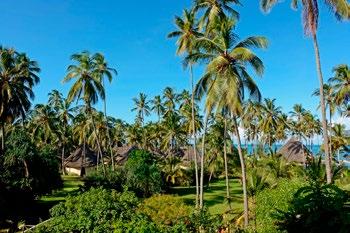

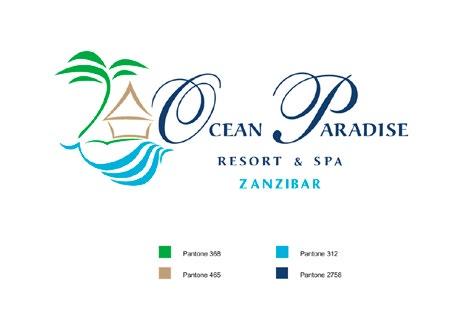

Botswana is a premier safari destination offering some of the best wilderness and wildlife experiences on the African continent. It continues to stand out in terms of its tourism offerings, making it a must-visit destination globally.
Key tourism assets include pristine national parks and game management areas, which are home to a great diversity of wildlife and flora; the Wilderness/ Wetlands experience, Culture and Heritage, Sports and Adventure and Business Tourism (Meetings Incentives, Conferencing and Events).
Experience in Botswana the stunning beauty of the world’s largest intact, inland delta, the Okavango Delta; the unimaginable vastness of the world’s second largest game reserve – the Central Kalahari Game Reserve; the isolation and other-worldliness of the Makgadikgadi, uninhabited pans the size of Portugal; the dramatic rocky and rugged wilderness; the Northern Tuli Game Reserve; and the astoundingly prolific wildlife of the Chobe National Park.
The ideal place for wildlife experiences, Chobe is home to the largest concentration of elephants on earth as well as large herds of zebra, Cape buffalo, giraffe and impala. Predators such as lions, the African wild dog and leopard sare also frequently seen along the river.
The Republics of Botswana and South Africa have joined forces in the promotion of natural resources conservation by forming the world’s first ever Transfrontier Park –“Kgalagadi Transfrontier Park” in Southern Africa. The Park was formed by merging the former Gemsbok National Park, which covers 28 400km2 of the extreme southwest of Botswana, and the former Kalahari Gemsbok National Park, which constitutes 9 591km2 of South African land South African side.
Declared a protected National Monument, the alluring Goo-Moremi Gorge is a remarkable sight with spectacular gorges, five ascending pools and mystical waterfalls.



Tap into your spirit of adventure at Savute Elephant lodge.
Evoking the feel of a timeless explorers’ lodge, our tented oasis immerses you in the untamed wilderness of Botswana’s Savute region.
The Tuli Block is a narrow fringe of land at Botswana’s eastern border wedged between Zimbabwe in the north and east, and South Africa in the south. It consists mainly of game farms offering safari tourism. The eastern section has now been touristically developed as a private game reserve called ‘Northern Tuli Game Reserve’
Declared a UNESCO World Heritage Site in 2002, the mystical Tsodilo holds profound religious and spiritual significance to the local San, whose ancestors have occupied the hills for millennia, and to the Hambukushu, who have also periodically occupied the hills for the past two years.
Declared the 1000th UNESCO World Heritage Site declared in 2014, Okavango Delta is the largest inland delta, descending from the highlands of Angola to the Kalahari.

Looking for an affordable but comfortable adventure for the family? An exciting romantic getaway? Thebe River Safaris offers affordable, comfortable airconditioned accommodation and en suite facilities. Explore hidden waterways on a river cruise, go on thrilling game drives and even opt for a trip to the Vic Falls! Facilities include a bar, restaurant, pool and clean campsite ablutions.
S 28°79'33 l E 29°48'33 +267 6250 995 resrvations@theberiversafaris.com www.theberiversafaris.com

Situated in northern Botswana, the entire Makgadikgadi Pans network is the largest single pan, and is famous for the unreal landscape of the pans and their Stone Age archaeological treasures, many of which still lie buried just beneath the surface.
Located in the heart of Botswana, the Central Kalahari Game Reserve (CKGR) is the largest and most remote game reserve in the whole of Southern Africa. The Reserve’s northern grasslands attract large herds of springbok, gemsbok, wildebeest, hartebeest, eland and giraffe. Of course, their predators are never far away.
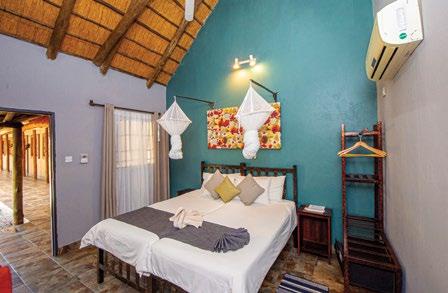


Set on remote Xaxaba island, on the passage routes of many species, Eagle Island Lodge has long been the ideal base from which to explore the Okavango Delta’s network of waterways and islands.

Think Africa is all the same? Step into Zambia and you’ll quickly realise that this landlocked nation beats to its own rhythm. It’s not just a destination; it’s an immersion into raw wilderness, ancient traditions, and the kind of peace that only comes from a place still untouched by mass tourism.
Zambia is a country shaped by water. Beyond the mighty Victoria Falls, the Zambezi River threads its way through gorges and valleys, providing lifeblood to wildlife and people alike. Dozens of lesser-known waterfalls, such as Kalambo Falls, one of the tallest in Africa, and Lumangwe Falls, often compared to a smaller Victoria, reward those who venture off the beaten path.
Safaris here feel different: wilder, more personal. South Luangwa National Park is famed for leopard sightings, while Kafue’s vast plains reveal cheetah and wild dogs. Zambia is also the birthplace of the walking safari, a humbling experience where every rustle in the bush sets your senses alight. Instead of ticking animals off a list, you become part of the landscape.
Zambia isn’t just about wilderness; its heartbeat is cultural. The annual Ncwala ceremony of the Ngoni people celebrates the harvest with feasts, dancing, and storytelling, while the colourful Likumbi Lya Mize festival of the Luvale showcases masked Makishi performers. These are not staged spectacles for tourists, but
centuries-old traditions that bind communities together.
Travel in Zambia often means slowing down. Chatting to market vendors selling dried fish and bright chitenge fabrics... Sharing nshima, the national staple, with new friends. Watching fishermen cast nets on Lake Bangweulu as shoebill storks stalk the reeds. Every moment feels unfiltered and real.
Adventure in Zambia is not confined to game drives. The legendary Tazara railway, built in the 1970s to link Zambia with the Tanzanian port of Dar es Salaam, is one of Africa’s great overland journeys. The two-day ride sweeps past villages, forests, and remote savannahs, offering a window into everyday life far beyond the tourist trail. It’s slow, sometimes unpredictable, but endlessly rewarding, a moving snapshot of Africa in motion.
What sets Zambia apart is the way nature and people coexist. Elephants wander freely near villages, and hippos grunt outside riverside lodges. Yet, despite the wildness, safety and stability are hallmarks of the nation, making travel surprisingly relaxed.
Zambia doesn’t shout for attention – it whispers, waiting for travellers willing to listen. Whether you’re drawn by its thunderous waterfalls, its festivals, or its gentle hospitality, the experience lingers long after you’ve left. This is Africa stripped back to its essence: wild, soulful, and unforgettable.















1. Master the magic hour at every destination
Africa’s dramatic sunrises and sunsets are legendary, from Durban’s ‘Golden Mile’ to the Serengeti’s endless horizons. The hour after sunrise and before sunset transforms ordinary scenes into extraordinary photographs. During these golden windows, harsh shadows soften, colours intensify, and even busy tourist spots take on an ethereal quality.
2. Use leading lines to draw the eye
South Africa’s landscapes are rich with natural leading lines – think Chapman’s Peak’s winding coastal road, the endless rows of Stellenbosch vineyards, or the dramatic cliff edges of the Fish River Canyon. These elements guide the viewer’s eye through your photograph, creating depth and visual interest.
3. Embrace negative space for impact
The vastness of the Karoo, the endless stretches of the Wild Coast, or the minimalist beauty of the Kalahari – these landscapes often call for breathing room in your compositions. Don’t feel compelled to fill every inch of your frame. Sometimes a lone baobab against an expansive sky tells a more powerful story than a cluttered scene.
4. Get low, get high, get different
Most travel photos are taken from eye level, but the most memorable shots often come from unexpected angles. Crouch down to capture a mountain range reflected in a tidal pool, climb to a higher vantage point for sweeping landscape views, or get close to
interesting textures, for example, the weathered wood of Muizenberg’s beach huts.
5. Weather is your friend, not your enemy
Don’t pack away your phone when the weather turns. Some of the most dramatic photography opportunities happen during storms, mist, or unusual weather conditions. The morning mist rolling over the Constantia wine valley, dramatic storm clouds gathering over the Highveld, or the otherworldly fog that sometimes shrouds the Tsitsikamma forest create moody, atmospheric images.
6. Tell the human story
Travel photography isn’t just about landscapes – it’s about capturing the spirit of a place and its people. Include hands preparing a traditional potjiekos, feet walking along Saly beach in Senegal, or silhouettes of fellow travellers against iconic backdrops. These human elements add scale, emotion, and narrative to your travel album.
7. Edit with restraint
Your phone’s built-in editing tools are surprisingly powerful. Adjust exposure, highlights, and shadows to bring out detail, but resist the temptation to over-saturate colours or apply heavy filters. South Africa’s natural beauty speaks for itself – your role is to enhance, not overpower.
The secret to exceptional travel photography lies not in your equipment, but in your willingness to explore, experiment, and see familiar places with fresh eyes. Your smartphone is simply the tool that captures what your adventurous spirit discovers.

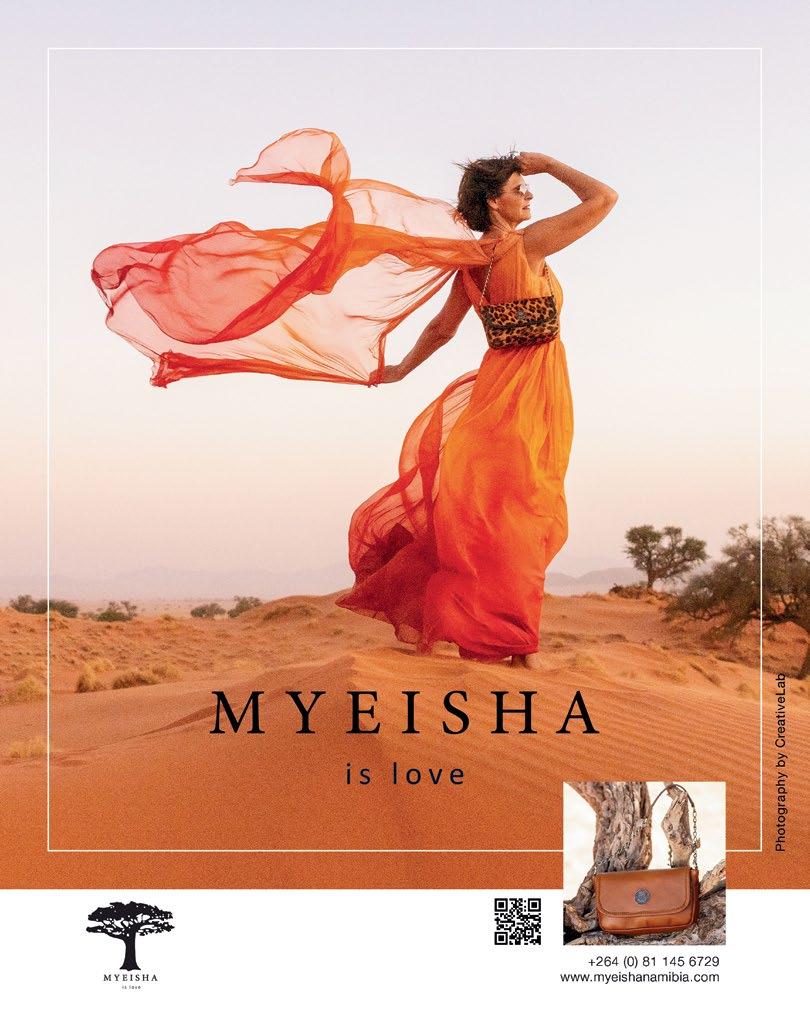

BY BYRON LUKAS
IF NAMIBIA WERE A MOVIE, IT WOULDN’T BE A SLOW-BURN DRAMA. IT’D BE AN IMAX ACTION BLOCKBUSTER — EPIC DESERT PANORAMAS, DUNES TALLER THAN THE BURJ KHALIFA AND AN OCEAN TEEMING WITH LIFE JUST OVER THE RIDGE, OBVIOUSLY WITHOUT THE GUNFIRE. HERE, ADRENALINE DOESN’T JUST LIVE IN YOUR VEINS; IT’S BAKED RIGHT INTO THE SAND. LET’S GO…

Meet Big Daddy — 325 metres of blazing red dune in Sossusvlei. You can hike up (your calves will send you hate mail) and then hurtle down on a sandboard. Think snowboarding, but hotter, drier, and with sand in places you didn’t know existed. Sit down rocket-style for pure speed or stand up for style points.
In Swakopmund, the dunes aren’t just for gazing at. They’re for throttling across on a quad bike. Zip through sandy valleys, crest ridges, and catch glimpses of the Atlantic shimmering like it’s in on your adventure.
Kayak
Walvis Bay Lagoon is basically the seal capital of Namibia. Hundreds of Cape fur seals swim beside your kayak, popping up to give you curious stares (and probably judge your paddling form). Flamingos and pelicans add a splash of drama to the scene.
Brave
It’s dramatic, eerie, and completely unforgettable. Charter a scenic flight over shipwrecks, seal colonies, and the roaring surf where desert meets ocean in a clash of elements worthy of a season finale.

In Damaraland, swap speed for stealth. Guided trackers will lead you on foot through the semi-desert, following fresh spoor until you spot the elusive, desert-adapted black rhino. It’s part heart-race, part conservation win.
May to October — sunny days, crisp nights, and the perfect excuse to stay outside from sunrise to starlight.
Fly into Hosea Kutako International Airport (Windhoek) and connect to adventure hubs like Swakopmund or Sossusvlei. Self-drive is the favourite!
From dune summits to seal-splashed bays, Namibia dares you to push your limits and rewards you with moments you’ll never forget.
Whether it’s a medical emergency deep in the bush or a security incident in the city, TravelSafe SOS connects you instantly to our Africa-based emergency control center. Peace of mind travels with you. Add TravelSafe SOS to every itinerary. Reduce liability. Elevate professionalism. Give your clients the reassurance they expect. Your Clients’


FUEL UP, FEAST, AND UNWIND AT THE CAPE’S TOP FAMILY DESTINATION. FROM FARM-FRESH DELIGHTS TO WEEKEND MARKETS AND EPIC KIDS’ FUN – DE WERF IS WHERE MEMORIES ARE MADE. JUST BEHIND THE ENGEN PETROL STATION, ADVENTURE AWAITS!

Just off the N7 between Malmesbury and the Melkbosstrand offramp, lies De Werf, a mustvisit destination for travellers and locals alike. Situated behind the Engen petrol station, this hidden gem offers more than just a convenient stop – it’s an experience waiting to be discovered. And it was even recognised, in 2025, as one of KFM’s Best Family Restaurants in the Cape.
A family-friendly haven
With a relaxed atmosphere, warm hospitality, and plenty of space for children to play, De Werf has quickly become a favourite stop for families.
The story behind De Werf
Engen De Werf officially opened in March 2023, following more than eight years of planning. The goal was simple: to create something truly special for both local residents and travellers along the busy N7 route between Cape Town and Namibia. Family values are central to the De Werf ethos, and the expansive layout reflects this commitment.
The De Werf experience
Since opening, De Werf has received an overwhelmingly positive response from the community and visitors. After refuelling at Engen De Werf, guests can enjoy a baristamade coffee and freshly baked pie at Café 365, pick up

essentials at the forecourt, or enjoy a sit-down meal at the onsite restaurant.
The farmstall is stocked with local produce, snacks, wine, and ready-made meals from the deli. Every weekend, the lively De Werf Food Market offers live music, a vibrant atmosphere, and a large play area for children to enjoy.
In just a short time, De Werf has hosted trail runs, quiz nights, more than 100 children’s parties, and the first of many signature events including BraaiFests, CarFests, and a four-day Easter Festival. The venue continues to grow as a hub for community and celebration.
Friends, families, and colleagues are all welcome to spend a beautiful day at De Werf, making memories in a setting that combines convenience with charm. Whether you're stopping en route or planning a day out, visitors can expect a warm welcome and a memorable experience.
De Werf Farmstall: Open daily from 8am to 6pm
De Werf Market: Saturdays and Sundays from 10am to 4pm
Location: Corner of R304 and N7, Philadelphia – less than halfway to Malmesbury
Contact: WhatsApp 064 867 8578 | www.dewerf.co.za






RICHARD OSMAN
The Impossible Fortune follows a daring young woman who uncovers a hidden inheritance tied to dark family secrets. As danger closes in, she must outwit powerful enemies and embrace her destiny in a quest for truth, legacy, and freedom. Thrills abound: kidnapping, murder, uncrackable codes...
BRIDGET MCNULTY
This pocket self-help book encourages us to find daily three-second “glimmers” of joy – like savouring delicious food, or the light through a window. With 1000+ micro-moments, cool illustrations and exercises, Daily Glimmers encourages readers to build resilience by embracing fleeting joys.
REESE WITHERSPOON
Army combat surgeon Maggie McCabe loses everything – her licence, her purpose... – until a secretive elite client offers her a high-stakes medical job. But when her patient vanishes, Maggie becomes a fugitive, forced to uncover a lethal global conspiracy.
VAN DER WESTHUIZEN
This gorgeous cookbook takes readers on culinary journeys to secret French and Italian locations and ancient medieval villages. Each recipe unlocks the essence of the places that captured Jan Hendrick’s heart, serving as a compass for memorable taste explorations and meaningful encounters.
ANTHONY FAIRALL
This guide offers game reserve visitors and southern African skywatchers an opportunity to discover magnificent starscapes. Features the ‘Big Five’ constellations, navigation steps, planet tracking, and Jupiter’s moons, and includes colourful charts, photos and expert tips for stargazers.
MASASHI MATSUIE
In 1980s Japan, young architect Tōru Sakanishi joins a prestigious firm and spends a transformative summer in a mountain village designing a national library, facing rivalries, and encountering four women who reshape his life. A lyrical, evocative tale.
CLAIRE ROBERTSON
Abandoned twice, Ellie Kent is left stranded in 19th-century South Africa. Joining a caravan of settlers, she faces danger, war, and wilderness alongside unlikely companions. The Immortalites is a powerful frontier tale of survival and the search for belonging.
M. L. RIO
Hot Wax is a gritty, highoctane rock ’n roll tale of a woman confronting a violent past, chasing freedom, and rediscovering herself on the road – fuelled by music, memory, and the ghosts of a childhood lost to fame and chaos. It's a vivid exploration of identity.









Pollinator Magnets: They attract bees, butterflies, and hummingbirds with nectar, colours, and sometimes strong scents.
Diverse Aromas: Many are fragrant, smelling sweet, spicy, or citrusy, with some even having mild sedative qualities!
Fungal Friends: Young Cattleyas rely on fungi in the soil for essential nutrients.
Survival Pods: Their thick pseudobulbs store water and nutrients, helping them survive droughts.
Two Styles: They come in “unifoliate” (one big leaf, a few big flowers) or “bifoliate” (two narrower leaves, more abundant but smaller flowers) types.
Not Parasites: They grow on trees for support, taking nothing from the host.
Hidden Benefits: Some compounds from their flowers have shown sedative effects and aid skin recovery.
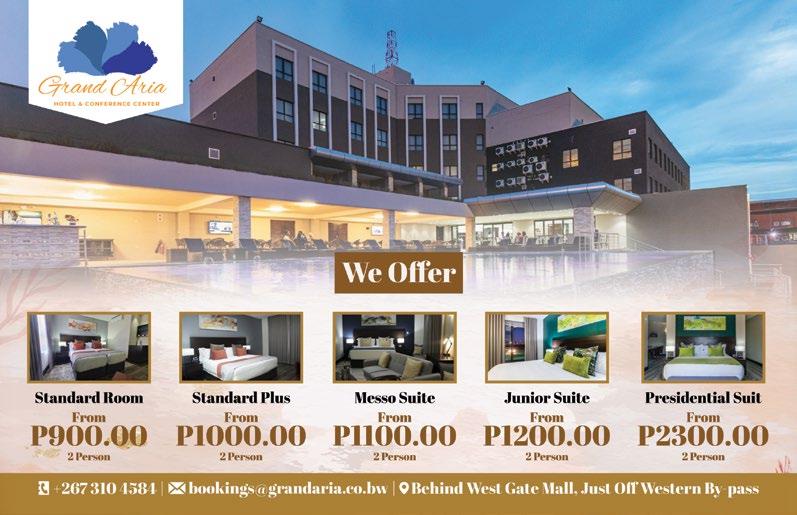

LETAMO is QWABI Private Game Reserve’s dedicated family-friendly lodge, where immersive wilderness experiences meet connection and comfort. Designed with multigenerational travel in mind, the lodge offers spacious suites with interleading options, child-friendly amenities, and tailored activities for every age. Located within one of only two UNESCO-declared savannah biospheres in Africa, guests can enjoy twice-daily Big Five game drives with expert guides and interactive bush experiences. From beautifully designed communal areas to curated kids’ programmes and scenic outdoor dining, LETAMO blends luxury with laid-back adventure, inviting families to create meaningful memories in the heart of the wild.
IN THE HEART OF ZIMBABWE, A REMARKABLE CONSERVATION STORY IS UNFOLDING AT MATUSADONA NATIONAL PARK, WHERE DEDICATED TEAMS ARE WORKING TIRELESSLY TO RESCUE AND REHABILITATE PANGOLINS – THE WORLD’S MOST TRAFFICKED MAMMAL.
Pangolins hold the unfortunate distinction of being the most illegally trafficked wild mammal in the world. With over two million pangolins poached annually, these scalecovered creatures face an uncertain future. Their scales, meat, and body parts are highly sought after in Asia, where pangolin meat is considered a delicacy and scales are believed to have medicinal properties.
At the forefront of Zimbabwe’s pangolin rescue efforts stands the Tikki Hywood Foundation, led by founder and CEO, Lisa Hywood. The organisation has been pioneering pangolin rehabilitation for over two decades, beginning with a single terrified female pangolin named Negomo, who arrived in a used mealie meal sack 23 years ago. What started as one woman’s determination to help a desperate animal has evolved into a comprehensive conservation programme that has successfully rescued, rehabilitated, and released numerous pangolins back into the wild.
The Tikki Hywood Foundation has partnered with
supported conservation work, ensuring that rescued pangolins receive specialised care before being safely returned to Matusadona National Park.
The programme has achieved remarkable successes. Take Mweya, a female pangolin rescued in June 2018 weighing just 4,1 kilograms and in severely compromised condition. Through dedicated rehabilitation efforts, she was successfully released back into the wild six months later weighing a healthy 6,5 kilograms – a testament to the expertise and care provided by the conservation teams.
Beyond rescue and rehabilitation, the programme makes a significant impact on local communities. The initiative supports local skills development and environmental awareness, enhancing community capacity to conserve pangolins while rekindling traditional knowledge and connections with these remarkable creatures.
Pangolins play a crucial role in maintaining healthy ecosystems. By digging up ant nests and termite mounds, they cycle air, water, and nutrients into the soil, promoting plant growth. They’re also natural regulators of those ant and termite populations, amplifying their importance to eco-health and making their conservation vital to Zimbabwe’s biodiversity.

The work in Zimbabwe is part of a broader international effort to save pangolins from extinction. The Pangolin Crisis Fund represents the world’s largest funding initiative dedicated to pangolin conservation, investing in projects that stop poaching, reduce demand, and raise awareness.
The Tikki Hywood Foundation continues to accept rescued pangolins and works closely with law enforcement agencies across the region. Their work represents a critical lifeline for a species that desperately needs our protection before it’s too late.








